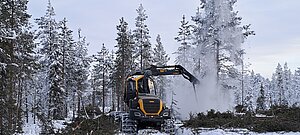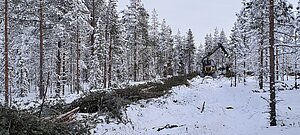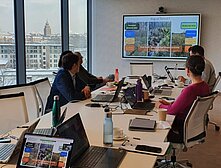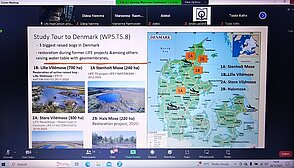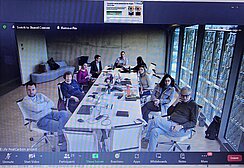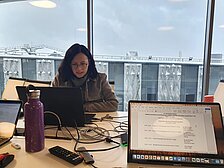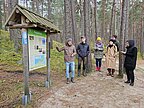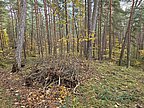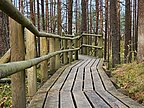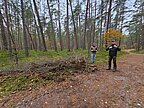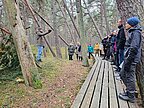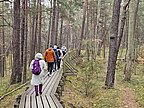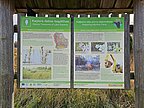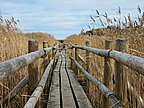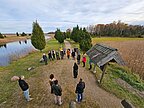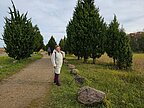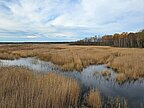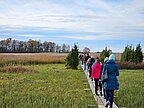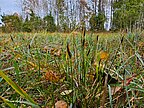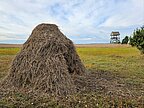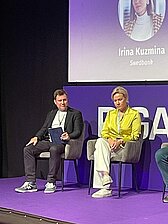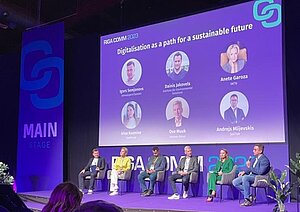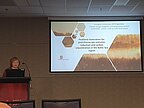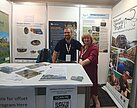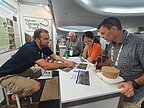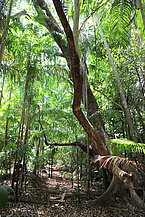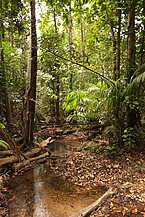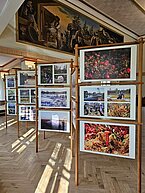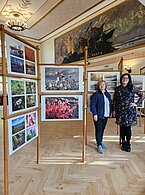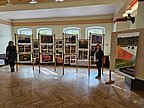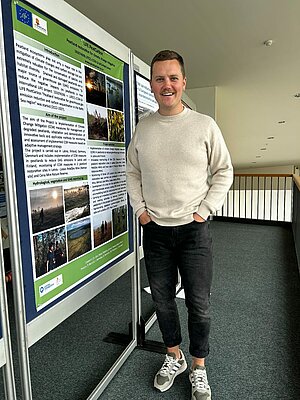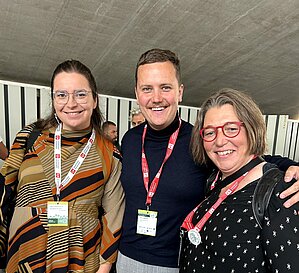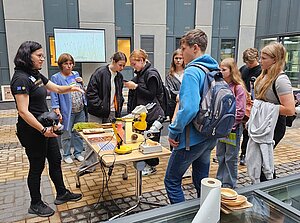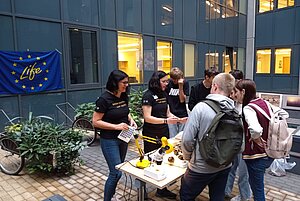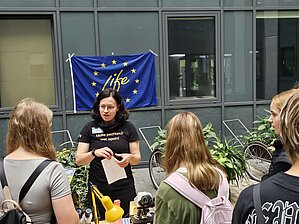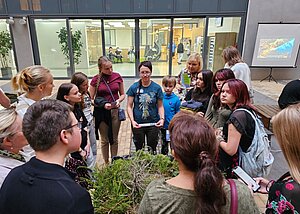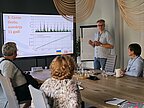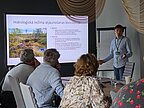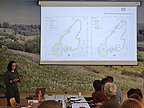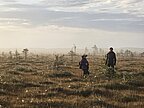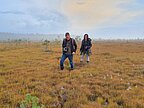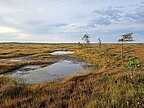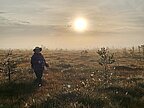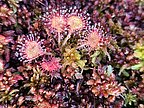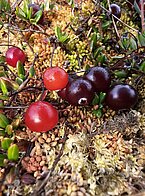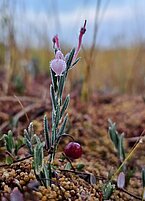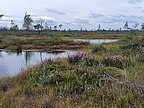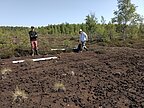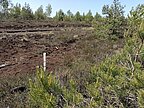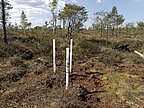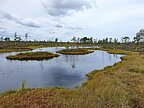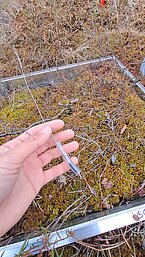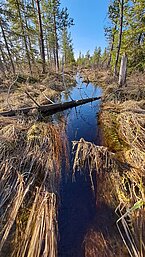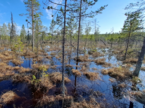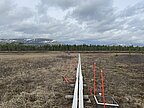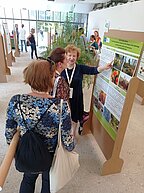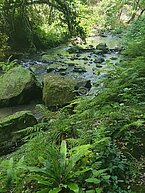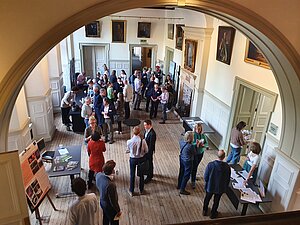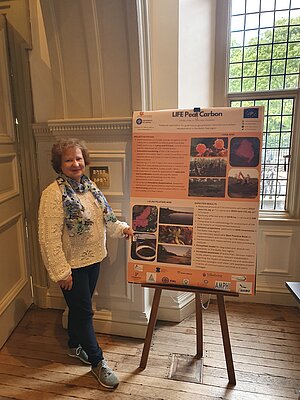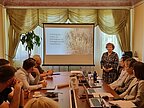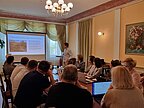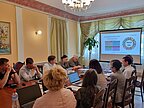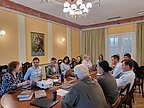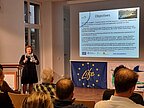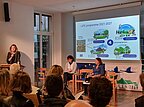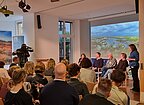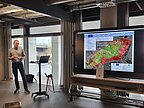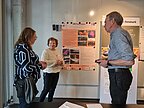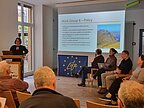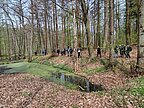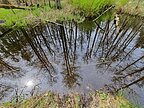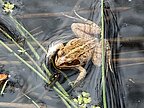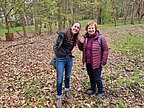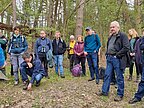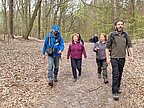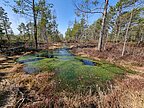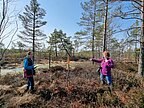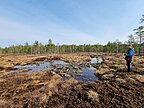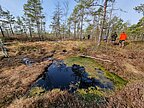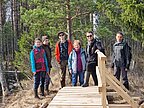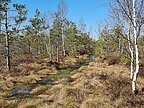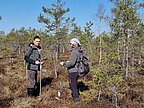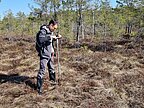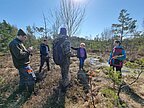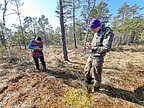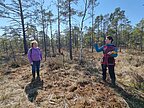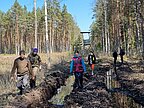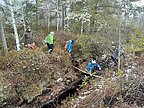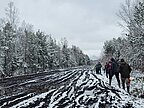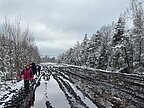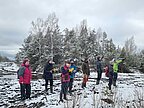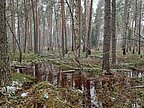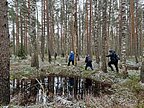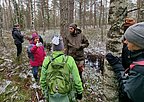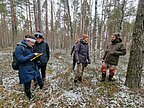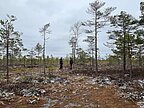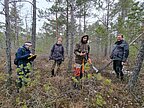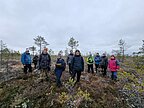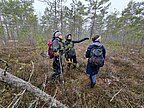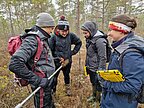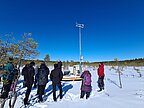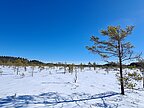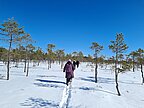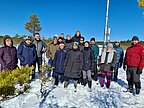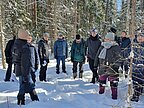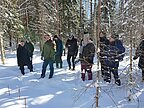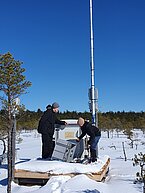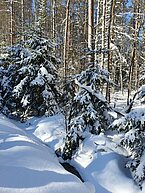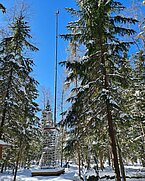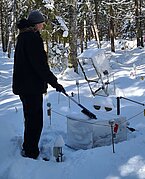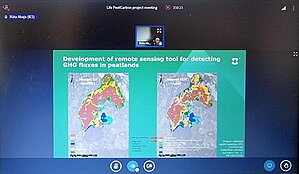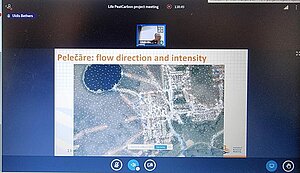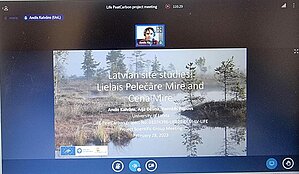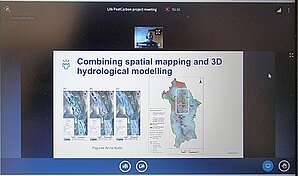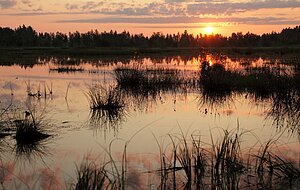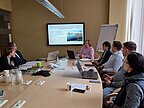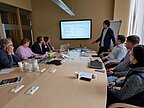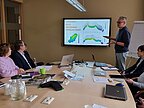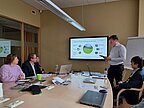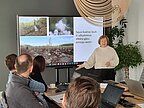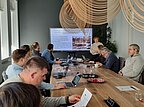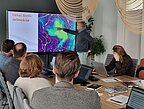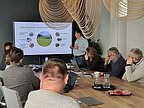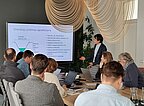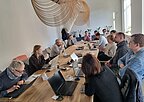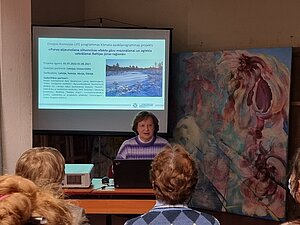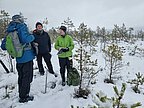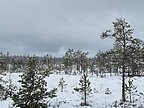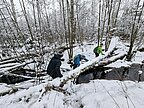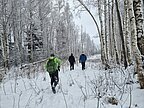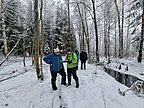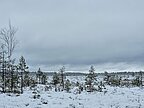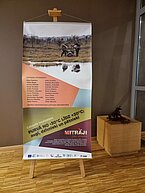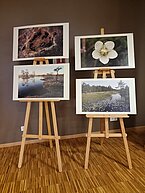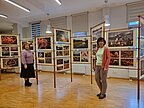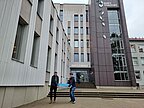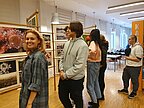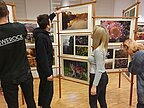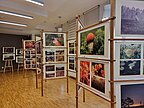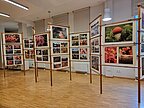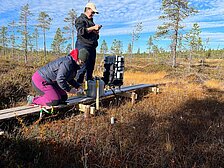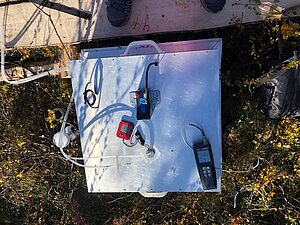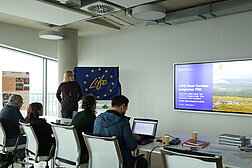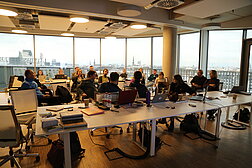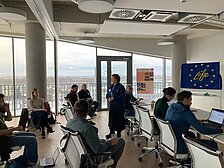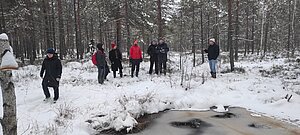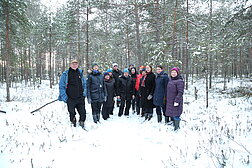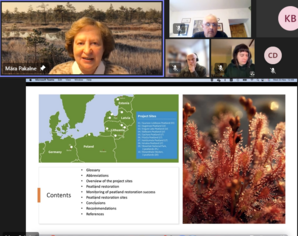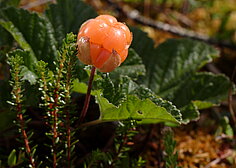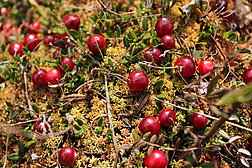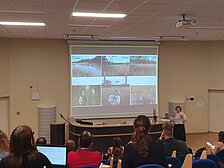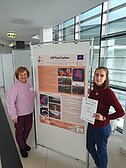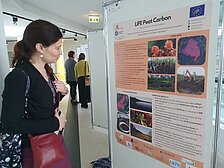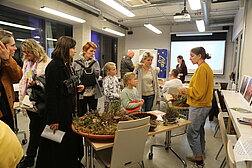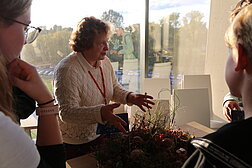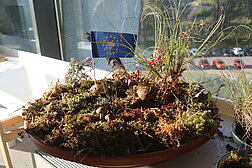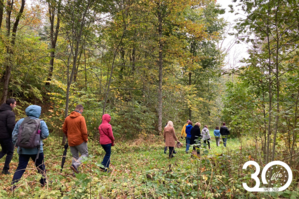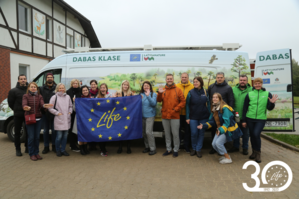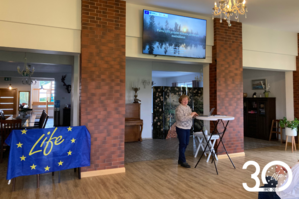The University of Latvia (UL) LIFE PeatCarbon project international traveling photo exhibition "Peatlands and Climate. Restoration Stories" from June 27 to July 31 is on display on the first floor of the Olaine History and Art Museum, located at Jelgavas Street 9-37, Olaine.
The exhibition showcases the work of 20 peatland researchers from three countries – Latvia, Finland, and Denmark – featuring four territories where peatland habitats are being restored, research is being conducted, and previously restored areas are being assessed.
The project’s goal is to implement peatland restoration measures in degraded raised peatlands while demonstrating innovative tools and application methods for monitoring and evaluating climate change mitigation efforts. Public awareness is an integral part of the project, which is why we invite you to explore this process through photo stories!
After Olaine History and Art Museum, the exhibition will travel to other cities in Latvia until the end of the project.
The photo exhibition has been prepared within the UL LIFE PeatCarbon project. Read more about the LIFE PeatCarbon project here.
Text: Roberts Gorodko
Photos: Roberts Gorodko
As noted in the journal by the project’s experts from Latvia, Finland, and Germany – Dr. Māra Pakalne, Dr. Tuula Aalto, Dr. Sari Juutinen, Dr. Jenni Hultman, Msc. Rūta Abaja-Felce, and Indigo Janka – this initiative combines scientific research with practical solutions.
What are the key insights expressed in the journal "EU Research" in the context of peatland restoration?
Peatlands as Carbon Stores
Peatlands in Europe have been extensively drained over centuries for agricultural and forestry purposes, thereby losing their natural capacity to store carbon. In wet, anaerobic conditions, peatlands accumulate carbon; however, when groundwater levels drop, intensive decomposition of organic matter begins, releasing carbon dioxide. In Latvia, peatland drainage began as early as the 1930s, and a large part of the peat was used for export, leading to a significant increase in greenhouse gas (GHG) emissions.
A Scientific Approach to Restoration
Project implementers from Latvia and Finland are conducting comprehensive research – from hydrological and geological surveys to GHG flux measurements using chamber and Eddy Covariance methods. In Latvia, particular attention has been given to Cenas Mire and the Great Pelečāre Bog, for which hydrogeological models have been developed and restoration potential assessed.
In Finnish sites such as Välisuo and Matorova peatlands, positive changes in groundwater levels were already observed in the summer of 2024 following dam construction. Restoration measures also include blocking drainage ditches and removing trees to restore wet conditions and reduce peat decomposition.
Innovative Data Analysis
The LIFE PeatCarbon team employs remote sensing data from satellites, drones, and aerial surveys, and adapts the GEST methodology to assess GHG emissions based on vegetation and hydrological indicators. These data are used to create GHG emission maps and to refine ecosystem models, which help predict how different restoration measures affect emissions.
The project also investigates the composition and metabolic changes of microbial communities, which can indicate the gradual return of the ecosystem to a more natural state following restoration activities.
International Collaboration and Sustainability
The LIFE PeatCarbon project actively collaborates with other similar European projects, particularly LIFE Multi Peat, which focuses on peatland restoration in Germany and other countries. Collaboration takes place at various levels – from expert meetings and joint discussions to the exchange of best practices and comparison of methodological solutions.
Dr. Māra Pakalne emphasizes that peatland restoration is not a one-off action but a continuous and multi-layered process:
"We are not only restoring specific areas but also creating databases, methods, and models that can be used elsewhere in Europe. Our goal is to achieve long-term benefits for climate policy.”
The project will continue until mid-2027; however, peatland restoration is a process that requires regular and long-term monitoring to fully evaluate its results. Monitoring is essential not only for assessing the effectiveness of ecosystem restoration but also for ensuring reliable data on GHG emission reductions needed for national GHG inventories and fulfilling commitments under the Paris Agreement.
The full article is available here.
Text: EU Research
Text adaptation for the University of Latvia LIFE PeatCarbon project website: Roberts Gorodko, Māra Pakalne
Photos: EU Research
Full reference: Pakalne, M., Aalto, T., Juutinen, S., Hultman, J., Abaja-Felce, R. and Janka, I. (2025) ‘Restoring peat for the climate’s sake, EU Research, Summer 2025 vol. (42), pp. 16 - 18.
On June 12, 2025, members of the LIFE PeatCarbon project management team and working group undertook a field visit to southwestern Finland to examine some of the region’s deepest and oldest peat soils. The objective of the visit was to explore different types of peatland ecosystems — both undisturbed and restored — and to assess their role in greenhouse gas (GHG) emission processes.
The field study was conducted at two sites: the Tervalamminsuo and Rottasniitunsuo peatlands. The excursion was led by Dr. Annalea Lohila, Associate Professor at the Institute for Atmospheric and Earth System Research, University of Helsinki, and researcher at the Finnish Meteorological Institute.
Tervalamminsuo Peatland: GHG Fluxes and Ecosystem Response to Simulated Drought
Tervalamminsuo is an undisturbed, intact raised bog with a nutrient-poor vegetation cover and a hydrologically active marginal zone that was restored more than 15 years ago. The site is equipped with a tall-tower measurement infrastructure used to monitor greenhouse gas (GHG) fluxes. An anemometer and a carbon dioxide analyzer operate at a frequency of 10 Hz to record high-resolution data. These data enable the calculation of carbon balance at 30-minute intervals, which are subsequently aggregated into daily and seasonal summaries. Measurement accuracy depends on wind direction and the prevailing aerodynamic footprint, which in this case spans approximately a 100-meter radius.
Carbon dioxide fluxes are assessed on a diurnal basis: during the day, the bog acts as a carbon sink, whereas at night it becomes a source of emissions. Adjacent to the eddy covariance tower infrastructure, there is also a platform for drought simulation experiments. As explained by the researcher, a specially constructed roof will be used to simulate short-term drought conditions in order to study plant water use and changes in photosynthetic activity under moisture stress. The experiments involve the use of a water isotope laser and the collection of precipitation samples to analyze water transport within plants and evapotranspiration dynamics.
The site is also equipped with soil temperature and radiation sensors, including detectors for photosynthetically active radiation (PAR) and shortwave radiation. According to the researcher, a visible difference in methane emissions can be observed across different sections of the peatland — emissions are more pronounced in areas with a higher water table, while methane uptake may occur in the drier marginal zones.
In addition to GHG measurements, the site has also been used for root growth monitoring, employing soil-inserted tubes and root imaging cameras. Groundwater level monitoring is also in place, enabling the assessment of hydrological fluctuations in the context of peatland restoration.
Rottasniitunsuo: Restored Forested Peatland and Variability in GHG Emissions
Rottasniitunsuo is a peatland area affected by forestry practices, where ecosystem restoration was carried out in 2024. Restoration measures included partial tree removal and ditch blocking to re-establish the natural hydrological regime. The site had originally been drained for forestry purposes and fertilised once. Vegetation regenerated from natural seed sources without artificial planting. Approximately 20 years ago, the area was rewetted; however, as noted by Dr. Annalea Lohila, many trees did not survive the rise in water table, although some remain viable.
This site is part of a national research programme focused on long-term monitoring of GHG fluxes following restoration. One of the key research questions—how methane emissions evolve over time after rewetting—has so far yielded inconclusive results. Recent measurements suggest that there is no consistent correlation between the time since restoration and the magnitude of emissions. Therefore, longer-term datasets and continued analysis are required.
Rottasniitunsuo features areas of varying soil fertility — in some parts, bilberries, bog rosemary, and lingonberries can be found, while other areas are significantly more nutrient-poor. It has been observed that tree canopies can intercept a portion of precipitation, preventing it from reaching the soil and causing it to evaporate. Researchers monitor changes in throughfall following tree removal in order to better understand water pathways within the ecosystem.
In the near future, there are plans to partially block the main drainage ditch and redirect water flow toward the forested area to raise the groundwater level and slow down peat decomposition. However, the rise in water level is intended to be moderate in order to avoid endangering the remaining trees. This intervention represents the next step in evaluating sustainable rewetting strategies.
Differences in Peatland GHG Emission Dynamics: Observations and Research Insights
The field visit to the Tervalamminsuo and Rottasniitunsuo peatlands provided project participants with an opportunity to compare two fundamentally different peatland ecosystems — one undisturbed and the other restored — and to better understand the complexity of GHG emission dynamics in such environments. Tervalamminsuo offers high-resolution, real-time data on carbon dioxide and methane fluxes, as well as a platform for modelling the effects of drought on plant physiological processes. In contrast, Rottasniitunsuo provides practical insights into the challenges of restoring a peatland previously used for forestry, particularly in relation to hydrological balance and the survival and adaptability of tree species.
Annalea Lohila emphasized that forestry practices such as continuous cover forestry can contribute to reducing GHG emissions, but they are insufficient to fully halt peat decomposition processes. Effective mitigation of GHG emissions requires a comprehensive approach that combines restoration engineering measures, continuous monitoring, and long-term climate impact projections.
Read more about the LIFE PeatCarbon project here.
Text: Roberts Gorodko, Māra Pakalne
Photos: Roberts Gorodko, Māra Pakalne
On June 11, 2025, the partners of the LIFE PeatCarbon project convened in Helsinki at the Finnish Meteorological Institute to assess the project's progress in Work Packages WP3 and WP4. The meeting focused on ecosystem service assessment, greenhouse gas (GHG) emission monitoring and modelling, as well as the application of the GEST (Geospatial Emission Sampling Technique) classification in emission calculations in Latvia and Finland.
Impact activities – Ecosystem assessment
This session of the meeting focused on evaluating the impact of peatland restoration using the ecosystem services approach. Aija Vanaga (Baltic Coasts) presented the methodology employed in the LIFE PeatCarbon project to identify and assess the ecosystem services provided by various habitat types. This approach captures both direct benefits—such as the reduction of greenhouse gas (GHG) emissions, improvement of water quality, and preservation of biodiversity—and indirect societal gains, including recreational opportunities and cultural values.
To ensure a comparable assessment across different pilot areas (Latvia, Finland), a harmonised indicator framework has been developed, enabling the quantitative characterization of wetland condition and associated services. Elīna Konstantinova (Baltic Coasts) emphasized that a key strength of this approach lies in its ability to integrate ecological, economic, and social dimensions, thereby fostering cross-sectoral collaboration.
During the discussion, experts addressed the challenges of data acquisition and comparability, particularly highlighting the need for detailed field observations and validation of remote sensing data. Preliminary results were also presented, demonstrating positive trends in several test sites in terms of both GHG emission reductions and structural diversity of habitats under restoration influence.
It was highlighted that the methodology developed under WP4 could potentially be integrated into future policy instruments, such as land use planning and climate adaptation strategies. The project foresees continued testing and adaptation of the indicators across varying climatic conditions to support methodological applicability throughout the Baltic Sea region.
Vegetation and GHG Emissions Monitoring in Latvia
In Latvia, greenhouse gas (GHG) monitoring in the context of peatland restoration is carried out by integrating the GEST type classification, chamber-based measurements, and remote sensing data. Līga Strazdiņa (University of Latvia) highlighted that the initial project data reveal a clear differentiation in GHG emissions across GEST types—wetter habitat units exhibit significantly higher methane emissions, while drier areas are dominated by carbon dioxide emissions resulting from respiration processes.
Aldis Butlers (SILAVA) presented GHG emission data and carbon balance calculations based on field chamber measurements. The data indicate a reduction in total emissions in several monitoring segments following restoration interventions. At the same time, the need for seasonal calibration was emphasized, as gas fluxes vary significantly depending on water levels, temperature, and vegetation phenology.
Agris Brauns (Institute for Environmental Solutions) introduced methods for structural ecosystem mapping and their integration into remote sensing data, enabling the extrapolation of GHG emission estimates across larger spatial scales. His methodologies combine multispectral satellite imagery, GEST type classification, and surface parameters, creating a foundation for scaling GHG monitoring from plot-level measurements to the landscape level.
During the discussion, experts agreed that GHG monitoring in Latvia currently relies on a multidimensional approach, where field measurements, modelling, and remote sensing complement one another. The need for continued data validation across diverse climatic and hydrological conditions was stressed to develop robust GHG assessment methodologies suited for future carbon market applications.
GHG Emission Assessment at Project Sites in the Pallas Region (Finland)
In the Välisuo and Matorovasuo peatlands, located in the Pallas region of Finland, an integrated approach is being implemented for GHG emission assessment, combining chamber-based gas flux measurements, GEST type classification, and remote sensing technologies. As Dr. Sari Juutinen (Finnish Meteorological Institute) explained, the methodology is based on GEST types defined by habitat moisture levels, vegetation structure, and other ecological parameters. This classification serves as a foundation for differentiating GHG emission calculations, assigning characteristic emission profiles to each GEST type.
Measurements indicate that wetter GEST types — such as those with high groundwater levels — are dominated by methane emissions, whereas drier types with greater tree cover and more active aerobic decomposition are characterized by higher carbon dioxide emissions. These findings confirm the strong dependence of peatland emissions on hydrological and microbiological conditions.
Aleksi Isomäki (Natural Resources Institute Finland) demonstrated how GHG emissions are projected at the landscape scale using remote sensing data from satellites and drones. Surface cover types identified through remote sensing are linked to emission coefficients derived from chamber data and GEST-type overlays. This enables the generation of spatial emission distribution maps, which are useful both for carbon balance assessments and for potential future carbon credit accounting.
However, the limitations of current models were also highlighted, particularly the need for calibration regarding seasonal emission dynamics and varying meteorological conditions. The discussion underscored the importance of increasing both the frequency of data collection and the accuracy of flux modelling to ensure more representative results across the entire landscape.
Hydrogeological modelling in Finland and Latvia
Within the framework of Work Package WP3, progress in hydrological modelling was presented for pilot areas in Finland and Latvia, with a particular focus on groundwater level simulation and model calibration.
The Finnish team – Anna Autio and Omar Nimr (University of Oulu) – introduced a modelling approach aimed at simulating groundwater dynamics in restored peatlands. Emphasis was placed on the necessity to integrate hydrological models with GHG emission models and ecosystem processes, given the significant role of groundwater levels in methane emission generation. The team is currently working on modelling surface moisture and groundwater levels and linking these parameters to other components of the project. Special attention is being given to implementing sub-daily resolution to improve model comparability with chamber and tower-based measurements.
On behalf of the Latvian team, Juris Seņņikovs (University of Latvia) outlined the groundwater level model calibration process, which is based on data from approximately 20 loggers installed at various observation sites. These loggers provide time series of groundwater level measurements. It was concluded that the limited data volume and relatively short measurement period pose significant challenges to reliable calibration.
The calibration process includes both qualitative assessment and quantitative adjustment, focusing on:
- the average water level at each monitoring site;
- seasonal amplitude alignment between simulated and observed data.
GHG Emission Modelling
Kielo Isomäki (Finnish Meteorological Institute) presented the ecosystem process model ESPA (Ecosystem Scale Peatland Model for Assimilation), which is currently being adapted and developed to reliably simulate GHG emissions across various peatland habitat types. The model is based on a system of process-based physical equations and integrates multiple modelling components.
Since the ESPA model operates in one dimension (1D), it cannot directly capture the micro-environmental heterogeneity of the landscape. Therefore, within the project, six distinct habitat types were defined based on vegetation data and GHG measurement results, allowing for separate modelling of both wet and dry peatland areas. Each habitat type was assigned specific physical parameters and vegetation structures to ensure accurate and differentiated simulation outputs.
Conclusion: Challenges and Next Steps
During the meeting, it was acknowledged that the GEST type classification often results in overestimated GHG emission values when compared to outputs from process-based models. A key recommendation was to use GEST types with caution in carbon credit accounting, especially in cases where local calibration is lacking. The discussion highlighted the critical need for interdisciplinary data integration—by combining modelling, field measurements, and remote sensing, a more reliable assessment of emissions can be achieved at both national and regional scales.
Participants agreed that future efforts should prioritize data quality verification, climate zone-specific modelling, and the structuring of metadata to enhance comparability and usability.
The second day of the meeting concluded with an overview of the planned field excursion on 12 June, which will take participants to some of the oldest and deepest peatland sites in Finland—Rottasniitunsuo and Tervalamminsuo.
Read more about the LIFE PeatCarbon project here.
Information about the third day of the meeting will be available soon.
Text: Roberts Gorodko, Māra Pakalne
Photos: Roberts Gorodko
As part of the fifth meeting of the LIFE PeatCarbon project’s management team and working group, the project’s international travelling photo exhibition “Peatlands and Climate. Restoration stories” was also opened in Finland. The exhibition visually showcases the project implementation sites in Latvia, Finland and Denmark.
The exhibition explains that:
- Peatlands store more carbon than forests, yet 70% of Europe’s peatlands are degraded;
- Drained peatlands become sources of carbon emissions, threatening climate targets;
- Restoration supports ecosystem services, carbon sequestration, and biodiversity;
- The exhibition serves as a public awareness tool, especially in urban environments where the majority of people live.
The photo exhibition features the work of 20 peatland researchers from three countries – Latvia, Finland, and Denmark – showcasing four project sites where peatland habitats are being restored, research is being conducted, and previously restored peatlands are being assessed.
At the exhibition opening, Māra Pakalne (University of Latvia) presented framed photographs by the authors as gifts to the peatland researchers based in Finland, expressing gratitude for their contributions toward the shared goal — raising public awareness about peatland restoration in degraded raised bogs through photo storytelling, while also demonstrating innovative tools and applied methods for monitoring and evaluating climate change mitigation efforts.
The message of the exhibition aligns with the United Nations Decade on Ecosystem Restoration (2020–2030) and the European Union’s goals of achieving climate neutrality by 2050.
Read more about the LIFE PeatCarbon project here.
Text: Roberts Gorodko, Māra Pakalne
Photos: Roberts Gorodko, Māra Pakalne
From 10 to 12 June, the fifth meeting of the LIFE PeatCarbon project’s management team and working group (PMT V) took place at the Finnish Meteorological Institute in Helsinki. Project partners from Latvia, Finland, Germany, and Denmark participated both in person and remotely. Key topics discussed included project sustainability, communication strategies, and the applicability of carbon credits in peatland restoration. The first day also featured a public event – the opening of an international photo exhibition.
The meeting was opened by Māra Pakalne (University of Latvia) and Tuula Aalto (Finnish Meteorological Institute). Emphasis was placed on the importance of in-person discussions and experience sharing, particularly on topics such as ecosystem service assessment, carbon accounting, and the comparison of monitoring methods. The excellent organizational cooperation of the Finnish partners was highlighted, along with a call to use the meeting as an opportunity for interdisciplinary communication.
Communication activities
Indigo Janka (NABU) remotely presented recent communication activities, including:
- A large-scale event and the opening of a photo exhibition in Berlin, organized in cooperation with the Embassy of Latvia in Germany;
- Media coverage of the event on social media, utilizing NABU’s official channels as well as Latvian media outlets.
An interactive workshop was held during the Helsinki meeting, where participants were invited to share their perspectives on the risks, benefits, and applications of social media in both professional and personal contexts. The following conclusions were drawn:
- Risks of using social media: disinformation, loss of credibility, threats to reputation;
- Risks of not using social media: missed opportunities to engage the public and a sense of “invisibility” within the project environment;
- Motivations for using social media: entertainment, consumption of information, publishing professional content, and public education.
Data were also presented:
- 5.24 billion people use social media, accounting for 63% of the world’s population;
- Northern Europe, including Latvia, ranks among the global leaders in social media use among adults, exceeding 70%;
- Social media is becoming a significant source of news – especially among younger demographic groups.
Sustainability, Replication and Exploitation of Results
Igor Semyonov (Ethno Expert) focused on carbon credit systems as one of the potential pathways for ensuring the project’s sustainability. His lecture was addressed not only to the project team but also delivered as a guest lecture at the Finnish Meteorological Institute.
Key points presented included:
- Carbon credit = 1 ton of CO₂ equivalent that is not released into the atmosphere;
- Project emission calculation model: area (ha) × GEST-type emission factor × crediting period;
- Comparison of baseline and target emissions provides the basis for calculating emission reductions.
Carbon credit – a unit representing one metric ton of carbon dioxide (CO₂) or its equivalent in other greenhouse gases that has either not been emitted into the atmosphere or has been removed from it.
GEST (Geospatial Emission Sampling Technique) type – a methodological approach used for the remote identification and assessment of greenhouse gas emissions, particularly in peatlands, by employing georeferenced data and technologies.
Semyonov emphasized the following points:
- VERRA is the leading standard in the voluntary carbon market (with VMW-36 being the specific standard for peatland restoration);
- It is essential to adhere to the principles of additionality, permanence, and leakage prevention;
- In Latvia, state-managed degraded peatlands (e.g., Rīgas Meži, Latvian State Forests) predominate, and their cautious inclusion requires scientifically validated data;
- A customized methodology is being developed for Latvia and Finland to verify emission reductions across different habitats and soil types;
- Template documentation is being prepared for VERRA certification, and workshops are being held on calculation methods.
VERRA standard – one of the world’s most widely used and trusted carbon credit certification standards, applied to validate emission reduction projects and issue them with tradable carbon credits.
Key takeaways:
- Peatland restoration can become an effective mechanism for attracting climate finance, provided that specific methodological requirements are met;
- A scientifically validated methodology for calculating emission reductions is a prerequisite for obtaining carbon credits and securing partner trust;
- Engagement of the public and stakeholders (including local communities, landowners, and state institutions) is essential for successful project implementation;
- The quality of the project will determine its market value; quantity is secondary;
- The project offers a scientifically grounded example of how ecosystem restoration can serve as a tool for achieving climate policy objectives.
The meeting in Helsinki marked a significant step forward in the implementation of the LIFE PeatCarbon project – moving from emission reduction modelling and risk assessment to active public engagement and scientific communication. Partner discussions highlighted that the key to the project’s success lies in interdisciplinary cooperation, scientific accuracy, and a transparent methodological approach.
In the coming years, the project will continue to test and adapt carbon accounting methods, develop documentation for certification, and prepare a platform for the broader implementation of peatland restoration programmes across the Baltic Sea region.
Read more about the LIFE PeatCarbon project here.
Information about the second and third days of the meeting will be available soon.
Text: Roberts Gorodko, Māra Pakalne
Photos: Roberts Gorodko
The University of Latvia (UL) LIFE PeatCarbon project international traveling photo exhibition "Peatlands and Climate. Restoration Stories" from June 9 to June 27 is on display on the first floor of the Mārupe Municipal Council building, located at Daugavas Street 29, Mārupe.
The exhibition showcases the work of 20 peatland researchers from three countries – Latvia, Finland, and Denmark – featuring four territories where peatland habitats are being restored, research is being conducted, and previously restored areas are being assessed.
The project’s goal is to implement peatland restoration measures in degraded raised peatlands while demonstrating innovative tools and application methods for monitoring and evaluating climate change mitigation efforts. Public awareness is an integral part of the project, which is why we invite you to explore this process through photo stories!
After being displayed at Mārupe Municipality, the exhibition will travel to cities across Latvia until the end of the project. It is planned to be on view at the Olaine History and Art Museum starting from June 27.
The photo exhibition has been prepared within the UL LIFE PeatCarbon project. Read more about the LIFE PeatCarbon project here.
Text: Roberts Gorodko
Photo: Roberts Gorodko
On May 22, 2025, the Latvian Embassy in Berlin opened its doors to a unique gathering – a cross-sectoral evening dedicated to one of Europe’s most overlooked climate heroes: peatlands. The event, organised by NABU within the framework of the LIFE PeatCarbon project, brought together scientists, policymakers, civil society, and private sector representatives from across Europe to explore one central theme: how restoring peatlands can drive a greener, climate-resilient, and financially viable future.
The evening began with opening remarks by Alda Vanaga, Ambassador of the Republic of Latvia to Germany and Ingo Ammermann (CEO, NABU), featured keynote speeches and panel discussions with Dr. Hans Joosten (Greifswald Mire Centre), Inese Kausa (European Commission), Jānis Ģērmanis (Riga Forest Agency), Frankie Turk (Re-Peat), Ari Pekka Auvinen (Finnish Natural Heritage Foundation) and Anna Uebachs (AECO).
Latvian Ambassador Alda Vanaga emphasized:
“Latvia is a green country – we are rich in forests, rivers, and peatlands. We take pride in being one of the European countries with the highest proportion of peatland ecosystems. This is both a privilege and a responsibility. We know that healthy peatlands store carbon, filter water, and support biodiversity. But when they are degraded, they significantly contribute to climate change. We have gathered here today because the climate crisis demands concrete and collective action – and peatland restoration is one of the most effective ways to respond.”
Beyond the ‘low-hanging fruit’
One of the evening’s key messages was that restoring peatlands is not as easy as it is often made out to be. While the emission savings from rewetting degraded peatlands are undeniable, turning policy into practice requires more than ambition. It requires long- term commitment, local know-how, and reimagined economies.
Discussions touched on the need for alternative value chains, particularly for wetland biomass, and how transition must include—not exclude—those whose livelihoods are tied to drained landscapes. The panellists made clear that peatland restoration is not simply a technical task, but a systemic challenge.
The emotional dimension of restoration
While the facts are clear, the event also made space for the emotional and intuitive aspects of restoration. One panelist shared how imagining the sensory experience of standing in a living peatland—wet, quiet, grounded—offers a more powerful motivator than data alone.
This perspective was echoed throughout the evening, not only in words but also in atmosphere. The immersive multimedia performance by Finnish collective Soiden Soidinmenot blended experimental jazz with projected visuals of northern landscapes, giving the audience a moment to appreciate the meaning of place, memory, and ecological change.
Collaboration, not certainty
A strong theme that emerged throughout the panels was that no single sector or country holds all the answers. In a field still marked by knowledge gaps, successful peatland restoration depends on learning from each other—across disciplines, regions, and roles.
The audience heard examples of both policy innovation and practical fieldwork. But equally, the speakers emphasized the importance of humility: the work ahead involves teaching each other, building experience, and staying open to complexity.
Visualising the path ahead
The evening also marked the opening of the LIFE Peat Carbon photo exhibition, a powerful visual storytelling exhibition that highlights both the beauty and fragility of European peatlands. From Latvia’s raised bogs to Finnish mires under restoration, the photographs captured what facts alone cannot: the emotional stakes and quiet hope of this work.
Looking forward
Peatlands are gaining recognition as critical ecosystems for climate, biodiversity and water. But recognition alone is not enough. Events like Peatlands, Climate and People show that momentum grows where ideas, emotions and networks meet.
We thank all those who joined us at the Latvian Embassy and look forward to building on this collective energy in the years ahead.
Also read the publications by the Ministry of Foreign Affairs of the Republic of Latvia and LVportals.lv about this event:
Ambassador Alda Vanaga: restoration of peatland is an effective tool to mitigate climate change
Vēstniece Alda Vanaga: kūdrāju atjaunošana ir efektīvs līdzeklis cīņā pret klimata pārmaiņām
Text: Indigo Janka
Photos: Sebastian Hennigs
The University of Latvia (UL) LIFE PeatCarbon project international traveling photo exhibition "Peatlands and Climate. Restoration Stories" is on display until June 5 on the second floor of the UL House of Sciences, located at Jelgavas Street 3, Riga.
The exhibition showcases the work of 20 peatland researchers from three countries – Latvia, Finland, and Denmark – featuring four territories where peatland habitats are being restored, research is being conducted, and previously restored areas are being assessed.
The project’s goal is to implement peatland restoration measures in degraded raised peatlands while demonstrating innovative tools and application methods for monitoring and evaluating climate change mitigation efforts.
After its display at the UL House of Sciences, the exhibition will travel to various cities across Latvia till the end of the project. During the summer period, it is planned to be showcased at the Mārupe Municipality Library.
The photo exhibition has been prepared within the UL LIFE PeatCarbon project. Read more about the LIFE PeatCarbon project here.
Text: Roberts Gorodko
Photo: Roberts Gorodko
On April 16, 2025, University of Latvia (UL) LIFE PeatCarbon Project Steering Group and Scientific Group meetings took place, both in person and online. The meetings were attended by 30 representatives from Latvia, Finland, Germany and Denmark who gathered to learn about the project's progress, share scientific results, and agree on future actions.
Dr. Māra Pakalne, the project manager of the UL LIFE PeatCarbon Project, stated in her presentation that on February 28 of this year, the mid-term technical and financial report of the project was submitted to the European Commission. Additionally, a monitoring expert from the European Commission visited Cenas Mire to observe the peatland restoration activities and ongoing hydrological and greenhouse gas (GHG) monitoring. The in-person meeting provided an opportunity to discuss the progress of the project's activities. In Latvia, permanent monitoring continues in Cenas Mire, Melnais Lake Mire, and Sudas-Zviedru Mire, evaluating the peatland restoration actions carried out in previous LIFE projects. Active planning of peatland restoration work is underway in Cenas Mire and Lielais Pelečāres Mire, while experts' opinions on protected peatland habitats are being gathered. Communication activities for the project are continuing, with a traveling photo exhibition prepared and brochures published about Cenas Mire and Lielais Pelečāres Mire. The project's results are being presented at scientific conferences.
Dr. Tuula Aalto from the Finnish Meteorological Institute (FMI) stated in her presentation that carbon flux measurements were carried out in various peatland habitats at project sites in Finland, specifically in the Matorova and Välisuo Mires, including after the restoration work, to assess differences in GHG emissions. The project is focused on the development of an Ecosystem Model, as well as the evaluation of ecosystem services. Additionally, areas with homogeneous landscape structures have been mapped to model and compare provisioning, regulating, and cultural services. She also shared information about habitat identification, focusing on six types. Drone flights were conducted before and after peatland restoration activities to acquire multispectral images for analysis. Regarding future activities, a photo exhibition will be launched, and the public will be informed about the peatland restoration process, with an emphasis on the importance of images and videos. Active cooperation with local and international partners will continue to strengthen communication and knowledge exchange about peatland restoration processes and their impact on peatland ecosystems. In June, the Project Management Team Meeting will also take place in Helsinki, with LIFE PeatCarbon project representatives participating.
Agne Šusta and Gints Šusts from AGS informed in their presentation that technical solutions for peatland restoration are being developed based on data entered into the Latvian Construction Information System and prepared designs. The main challenge is the need for expert opinions on protected species and habitats, which is delaying the design process. In parallel, a peatland exhibition is being created at the UL Botanical Garden.
Dr. Jenni Hultman from the Finnish Natural Resources Institute (LUKE) in her presentation summarized the results from peatland restoration areas in Finland, highlighting changes in microbial communities after restoration. The research results presented showed a decrease in GHG emissions related to changes in microbial activity. She emphasized that microbial analysis provides crucial insights into ecosystem restoration processes and is an important tool for future peatland management.
Aija Vanaga from Baltijas krasti introduced the approach to ecosystem services assessment within the LIFE PeatCarbon project. The first version of the maps was presented, with data groups related to provisioning, regulating, and supporting cultural (non-material) services, based on expert input and available data. The aim of the assessment is to highlight the human benefits derived from the management of various peatland areas, taking into account spatial and qualitative information.
Igors Semjonovs from EthnoExpert provided insights into the development of carbon credits and their potential use within the LIFE PeatCarbon project. He emphasized the need for a clear methodology for the carbon market and opportunities for cooperation with international institutions. Additionally, it was noted that sustainable ecosystem management is essential for reducing greenhouse gas emissions and tapping into market potential.
Dr. Sari Juutinen and Jack Chapman from FMI presented the GHG monitoring results in Finland, using cameras and Eddy covariance tower results. They compared GHG emissions before and after peatland restoration, with a particular focus on different habitat types. The results indicate that after restoration, GHG emissions decrease, but the effect is dependent on the site-specific conditions and hydrological factors.
Dr. Andis Lazdiņš and Aldis Butlers from SILAVA presented an overview of the development of GHG emissions monitoring in Latvia, with a particular emphasis on emissions measurements in various habitat types. They analyzed emissions differences between drained, restored, and natural areas, revealing lower emissions in areas with higher groundwater levels. The need for long-term data collection for the quantitative assessment and monitoring of GHG emissions was highlighted.
Dr. Jānis Bikše, Dr. Ilga Kokorīte, and Kārlis Pikšens from the UL presented innovations in carbon dioxide emissions measurements in open water using low-cost sensors and camera methods, which enable continuous monitoring. The studies used various examples of peatland and lake ecosystems in Latvia, such as the Melnais Lake Mire and Cenas Mire, compiling initial results on carbon dioxide fluxes over a 24-hour period. They highlighted future plans to expand measurements and improve data quality, particularly under night-time measurement conditions.
Dainis Jakovels, Jevgēņijs Filipovs, and Rūta Abaja from the Environmental Solutions Institute presented remote sensing results that allow for the identification of various GHG emission sources (GEST) categories in Latvia's peatlands and forests using satellite imagery and other remote sensing techniques. They demonstrated examples of GEST classification and compared different forest and peatland ecosystem types to understand carbon dioxide and methane emission fluxes. They emphasized the need to develop higher-resolution satellite data and improve time and spatial accuracy to obtain direct emissions measurements.
Dr. Andis Kalvāns and Konrāds Popovs from the UL presented an overview of hydrological monitoring in Latvian project sites and peatland restoration areas, including water level monitoring and the study of moisture conditions that affect carbon accumulation. They discussed the measurement techniques and equipment used, as well as the results, which show groundwater flow and soil moisture levels at different locations. They emphasized the need to continue monitoring to improve hydrological models, which will aid in planning more effective peatland restoration actions.
Uldis Bethers, Juris Seņņikovs, and Andrejs Timuhins from the UL presented hydrogeological modeling results for Cenas Mire and Lielais Pelečāres Mire in Latvia, aiming to better understand groundwater flow and its impact on the peatland's hydrological regime. The models were applied to assess groundwater flow, water level fluctuations, and other hydrological phenomena in the project sites, offering new opportunities to optimize water resource management. They also discussed the need to adjust the models to different conditions to ensure more accurate results and a more successful peatland restoration process.
Omar Nimr and Dr. Anna Autio from the Oulu University presented an overview of hydrogeological studies and groundwater models conducted to analyze peatland restoration sites in Finland. The studies included evaluating water flow, groundwater accumulation, and their impact on carbon emissions, providing crucial data for the development of future restoration strategies. They analyzed specific hydrogeological conditions that could affect groundwater quality and quantity in Finnish peatlands, offering the necessary data for further restoration activities.
Both the Steering Group and the Scientific Group meetings confirmed the significant contribution of the LIFE PeatCarbon project to carbon sequestration and emission reduction in peatlands. The synthesis of scientific results, proposals for technical solutions, and public education increase the impact of the results achieved and provide the foundation for the continued development of peatland restoration.
Read more about the LIFE PeatCarbon project here.
Text: Roberts Gorodko, Māra Pakalne
Photo: Māra Pakalne
Peatlands are among the most important ecosystems on our planet. But they are under enormous pressure. Let's get together to explore the state of peatland restoration and the pathways to a greener future with some of Europes leading experts. Event registration is now open!
Ever wondered why people keep on talking about peatlands? You will know after our event on the 22nd of May in Berlin!
Rich in biodiversity, peatlands play a crucial role in climate regulation and water cycling. Over thousands of years, these landscapes have formed deep layers of peat – acting as immense carbon sinks. However, due to drainage and degradation, vast amounts of greenhouse gases are now being released, accelerating global warming. Clearly, the need for restoration has never been more urgent.
Hosted by the LIFE PeatCarbon project, the event "Peatland, climate and people: A conversation for a greener future" brings together experts from across Europe to explore the state of peatland restoration and the pathways to a greener future. Through thought-provoking keynotes and dynamic panel discussions, we will highlight innovative solutions that drive real impact.
Beyond the discussions, this evening is an opportunity to connect and collaborate with leaders from science, policy, business, and civil society. Expect insightful conversations, live performances and a curated selection of food and drinks in a setting designed to spark ideas and partnerships.
What: Peatland, climate and people: A conversation for a greener future | networking event
When: Thursday, 22 May | 17:00 to 21:00 (CET)
Where: Embassy of the Republic of Latvia, Reinerzstraße 40/41, 14193 Berlin
Read more here.
Text: Indigo Janka
Photo: Māra Pakalne
Starting from March 31, the international traveling photo exhibition of the University of Latvia (UL) LIFE PeatCarbon project “Peatlands and Climate. Restoration Stories” will be on display on the 1st floor of the Environmental Education Centre “Botania” at the National Botanic Garden of Latvia, located at Miera Street 1, Salaspils.
The exhibition showcases the work of 20 peatland researchers from three countries – Latvia, Finland, and Denmark – featuring four territories where peatland habitats are being restored, research is being conducted, and previously restored areas are being assessed.
The project’s goal is to implement peatland restoration measures in degraded raised peatlands while demonstrating innovative tools and application methods for monitoring and evaluating climate change mitigation efforts.
The photo exhibition at the National Botanic Garden of Latvia will be on display until May 12, after which it will travel to various cities across Latvia till the end of the project.
The photo exhibition has been prepared within the UL LIFE PeatCarbon project. Read more about the LIFE PeatCarbon project here.
Text: Roberts Gorodko
Photo: Roberts Gorodko
On Wednesday, March 5, the University of Latvia (UL) LIFE PeatCarbon project team met with representatives of “Riga Forests” Ltd to discuss potential future plans and projects, as well as to share presentations on completed and planned activities within the project. A total of 20 people participated in the meeting.
Peatland restoration in Latvia and Finland within the UL LIFE PeatCarbon project continues, and the results are already visible. Measures implemented in Finland indicate positive trends – after the restoration works, a reduction in greenhouse gas emissions has been observed.
In Latvia, hydrological restoration works for peatlands are planned for 2025. Until then, hydrological and greenhouse gas monitoring continues, along with vegetation mapping using remote sensing methods.
As highlighted in the presentation “Overview of Achievements in the LIFE PeatCarbon Project”, project manager Māra Pakalne stated that three key documents have been prepared within the project: Hydrological Restoration Plan in Cena Mire, the initial environmental assessment, and the monitoring reports. She noted that a total of 26 activities are being implemented in the project, with two already completed. Additionally, young people are actively involved – Latvian and international students participate in research, laboratory work, and expeditions to project sites.
Various monitoring activities are still ongoing in Latvia to track changes in peatland conditions following restoration measures. In the presentation “Hydrological Restoration Plan for Cena Mire”, senior expert Līga Strazdiņa emphasized that the Hydrology Restoration Plan for Cena Mire is based on previously developed Nature Conservation Plan and extensive geological research. A technical project is being developed, drawing on information from the Hydrology Restoration Plan for Cena MIre, and collaboration with landowners and managers ensures that the measures can be precisely adapted to real-world conditions.
The acquisition and analysis of hydrological data are essential components of the project. In the presentation “Hydrological Observations in Cena Mire and Melnais Lake Mire”, lead researcher Andis Kalvāns explained that monitoring stations have been installed in Cena Mire and Melnais Lake Mire to study water level fluctuations and the peatland restoration process. Current data indicate that following restoration measures, the water level has stabilized and remains higher than before. However, in some areas, the effectiveness of restoration is limited – water drains through sediments or does not reach the required levels, necessitating additional solutions. Greenhouse gas emissions analyses and soil sample tests are also being conducted to assess the dynamics of peatland ecosystem recovery.
Although the project primarily focuses on restoring the hydrological regime, potential measures for post-peat extraction areas are also being discussed. Restoring water levels in former peat extraction sites is more complex, making it crucial to plan long-term solutions that will facilitate the return of natural processes to these areas. Kalvāns pointed out that the project provides valuable insights for future hydrological interventions, as the collected data helps to more accurately predict and model water level changes.
Project expert Rūta Abaja-Felce from the Institute for Environmental Solutions, in her presentation “Application of Remote Sensing for Cena Mire and Melnais Lake Mire”, explained how remote sensing methods are used to better understand peatland ecosystem dynamics and their impact on greenhouse gas emissions.
One of the most significant aspects of the research is data collection using aerial and satellite technologies. These data allow for modeling peatland ecosystem changes, analyzing water level fluctuations, and assessing vegetation composition. For instance, Finnish researchers integrate these data into their ecosystem models, which help predict how peatland restoration will affect greenhouse gas emissions.
The study also employs multispectral imaging, which enables the identification of vegetation types and provides insights into how different peatland areas absorb and release carbon dioxide and methane. To refine remote sensing methods, researchers conducted on-site fieldwork in the peatlands, comparing image data with actual vegetation species and hydrological conditions.
Project expert Andis Lazdiņš from the Forest Research Institute “Silava”, in his presentation “Greenhouse Gas Measurements in Cena Mire and Melnais Lake Mire”, explained that the primary factor influencing greenhouse gas emissions in peatlands is groundwater level fluctuations. While continuous monitoring of water level changes is being carried out, it is also crucial to understand soil properties up to a depth of one meter, as these can significantly affect emission volumes and dynamics.
One key finding of the study is that in areas where the groundwater level remains below 10 centimeters in summer, emission levels can increase significantly. Conversely, in locations where the water level remains higher, the negative impact of emissions may be lower. Measurements indicate that dissolved organic carbon concentrations in peat extraction fields are significantly higher than in agricultural lands, highlighting the impact of peat degradation.
Special attention is also given to methane and carbon dioxide emissions. While methane remains in the atmosphere for a shorter time than carbon dioxide, its climate impact is much more intense. Research data show that after groundwater level restoration, emissions initially increase but tend to stabilize over the long term.
Lazdiņš emphasized that modeling solutions are continuously being refined to more accurately predict the impact of peatland restoration on the climate. He also stressed the need to continue measurements and improve data collection to develop more precise emission models.
Elīna Konstantinova from "Baltic Coasts", in her presentation “Ecosystem Services”, explained that an assessment of ecosystem services is currently underway in the pilot areas – Cena Mire in Latvia and two sites in Finland. The process is ongoing, and a baseline assessment is being conducted, incorporating both biophysical and economic aspects. The full analysis of ecosystem services is expected to be completed by 2027.
The assessment methodology is based on approaches used in previous studies. This means that ecosystem service evaluations are conducted by geographic units, analyzing all habitat types and land cover categories in the respective areas. Experts identify key indicators to capture a wide range of ecosystem services as comprehensively as possible. Additionally, an indicator table is being developed, systematically compiling data from field observations and past research.
Particular attention is given to the economic valuation of ecosystem services. Konstantinova emphasized that this is not about determining their market value but rather about comparing and assessing their significance.
Project expert Igors Semjonovs from EthnoExpert, in his presentation “Carbon Credit Assessment”, discussed the development of carbon credit certification in Latvia and ongoing cooperation with international experts. Under the European regulatory framework, these issues are being adapted at the national level, and Latvia is currently collaborating with Finland to establish a dialogue on the certification process.
Regarding Verra certification, several seminars have been held in Latvia, involving experts from Ireland and the Netherlands. The only Verra-standard project registered in Latvia is still in its initial phase, and the seminars have explored various aspects of certification and its adaptation to Latvian conditions.
Semjonovs emphasized that Latvia's approach differs – instead of strictly following existing methodologies, the focus is on adapting them to specific landscapes and real conditions. Currently, all information gathered within the project is being compiled for use in training seminars, providing landowners with a clear understanding of the process.
However, in the context of Verra certification, one of the main challenges is proving the project's impact – demonstrating the reduction in emissions before and after implementation.
Gints Šusts from AGS Systems briefly introduced the upcoming LIFE PeatCarbon project activities, which will focus on restoring the hydrological regime of Cena Mire, further elaborating on the aspects mentioned by his colleagues.
In the concluding part of the meeting, Jānis Ģērmanis, board member of "Riga Forests” Ltd, shared the company's vision for the future, particularly regarding the restoration of former peat extraction sites and the exploration of new solutions for these areas. Unlike Natura 2000 sites, where restoration efforts are already in progress, "Riga Forests” is focusing on non-Natura 2000 areas, where large-scale peat extraction has taken place.
The meeting was also attended by the following representatives from "Riga Forests": Edmunds Račinskis, Madara Konuša, Gatis Eriņš, Ieva Roze, Modris Martinovs, Andra Feldmane, Juris Zariņš, and Kristīne Kiršbauma.
Read more about the LIFE PeatCarbon project here.
Text: Roberts Gorodko
Photo: Roberts Gorodko, Māra Pakalne
On 28 February 2025, the 83rd Scientific Conference "Climate and Waters" was held at the Nature House of the University of Latvia, where Jānis Bikše, co-authored by Kārlis Pikšēns and Ilga Kokorīte, presented a report on the progress in the LIFE PeatCarbon project. The presentation demonstrated an innovative, relatively low-cost approach to estimating CO2 fluxes in open water bodies using home-made equipment.
The devices developed to measure CO2 concentrations and fluxes were based on a low-cost CO2 sensor module, which is several times cheaper than commercially available sensors for dissolved CO2 in water. The ideas for the sensor were taken from scientific publications and adapted to the needs of monitoring wetland water bodies.
Using these sensors, the first measurements of CO2 concentrations and fluxes were carried out in autumn 2024 in the LIFE PeatCarbon project sites - Skaists Lake in Cena Mire and Melnais Lake Mire flooded peat fields. Preliminary results show that CO2 is higher in peatland water bodies than in the atmosphere, and that dystrophic peatland lakes mainly emit CO2 rather than absorb it.
Fieldwork also revealed technical challenges - CO2 sensors are sensitive to humidity, which limits their use, especially at night when fog often makes data inaccurate.
Research will continue in the spring and summer of 2025 to complete the set of measurements and analyse the results. In addition, open water surface area calculations are being carried out in the Cena Mire and Melnas Lake Mire to extend the measurement results to the wider bog area and to obtain an estimate of total CO2 emissions from bog water bodies, including lagoons and ponds.
Presentation abstract available here.
Conference presentatation here.
Text: Jānis Bikše, Ilga Kokorīte
Photo: Jānis Bikše, Māra Pakalne
On Monday, February 24, the LIFE PeatCarbon project’s international traveling photo exhibition “Peatlands and Climate: Restoration Stories” was opened at the University of Latvia (UL) House of Nature, bringing together UL and project representatives, collaboration partners, and peatland ecosystem enthusiasts.
The exhibition showcases the work of 20 peatland researchers from three countries – Latvia, Finland, and Denmark – featuring four territories where peatland habitats are being restored, research is being conducted, and previously restored areas are being assessed. The project’s goal is to implement peatland restoration measures in degraded raised peatlands while demonstrating innovative tools and application methods for monitoring and evaluating climate change mitigation efforts.
Overall, the photo exhibition reflects seven territories. They include Cena Mire, Lielais Pelečāre Mire, Melnais Lake Mire, and Sudas-Zviedru Mire in Latvia, Matorovansuo and Väliuo peatlands in Finland, as well as Stenholt peatland in Denmark.
At the opening of the photo exhibition, UL Vice-Rector for Development, Enno Ence, expressed gratitude to the project team and highlighted one of the most important conclusions – Latvia’s natural environment offers unique opportunities for research, particularly in relation to peatland ecosystems:
"Latvia has peatlands that can no longer be found elsewhere, and they provide not only valuable scientific opportunities but also challenges — in terms of both nature conservation and climate neutrality. For scientists and students, this is a great opportunity to explore an ecologically fragile yet locally and globally significant environment in depth."
Similarly, Kristaps Kunrads, Director of the UL Botanical Garden, expressed gratitude to the project team and collaboration partners, emphasizing that, while the work invested may not always be immediately visible in everyday life, it is highly valuable.
Kunrads explained that peatlands serve as habitats for numerous plant and animal species, forming a unique ecosystem in which humans could not exist without these species:
"Your work helps protect this environment while also contributing to the reduction of greenhouse gas emissions. You are safeguarding not only the peatlands but our planet as a whole."
He also pointed out that research in this field is a major challenge – it is not simply a walk through the forest among trees and shrubs. Identifying a specific plant species in this environment requires persistence and expertise.
At the opening of the photo exhibition, UL Botanical Garden’s Scientific Director, Signe Tomsone, emphasized that this event is not only significant in the context of science and research but also holds global importance both ecologically and economically:
"Peatlands are unique climate-regulating systems – they function like giant sponges, absorbing and regulating water exchange in the environment. However, human activities, such as drainage, significantly alter this balance. Today, we increasingly see that droughts and forest loss are direct consequences of how we manage our environment."
She added that scientific research is crucial in understanding these complex processes, and UL has made substantial progress in this field by attracting funding and implementing long-term projects. She expressed special thanks to Māra Pakalne, the LIFE PeatCarbon project manager, whose efforts have convinced both the European Commission and public partners of the project's significance as a major contribution to Latvian science and environmental protection.
Following this, project leader Māra Pakalne introduced the process behind the creation of the photo exhibition, thanking the project team and emphasizing that both the exhibition and the project’s achievements are the result of many people’s dedicated efforts:
"Researchers have embarked on expeditions at various times and under different conditions, often spending nights in peatlands to collect data. This work highlights not only the unique value of Latvia’s peatland ecosystems but also the experience of our collaboration partners in Finland, where research takes place under extreme conditions – such as in Lapland, where areas are covered in a meter of snow, and fieldwork is often conducted alongside reindeer."
She revealed that the main challenge in Latvia is the vast peatland areas – with difficult access and over 5 000 hectares requiring detailed study. This research not only showcases the beauty of peatlands but also provides valuable insights for long-term conservation and restoration efforts.
As displayed on the exhibition poster, the project's symbol is the cloudberry (Rubus chamaemorus) – a plant that is very rare in Latvian peatlands but remains an essential part of the ecosystem in Finland.
“This symbol reminds us of the fragile balance of nature and the need to preserve these unique landscapes,”
emphasized Pakalne.
At the conclusion, the awarding of the photo exhibition authors took place, followed by informal conversations, a tour of the exhibition, and an introduction to the project booklets, calendar, and book.
The photo exhibition will be on display on the 1st floor of the UL House of Nature until March 31, after which it will travel to various cities across Latvia till the end of the project.
The photo exhibition has been prepared within the UL LIFE PeatCarbon project. Read more about the LIFE PeatCarbon project here.
Text: Roberts Gorodko
Photo: Roberts Gorodko, Māra Pakalne, Toms Grīnbergs
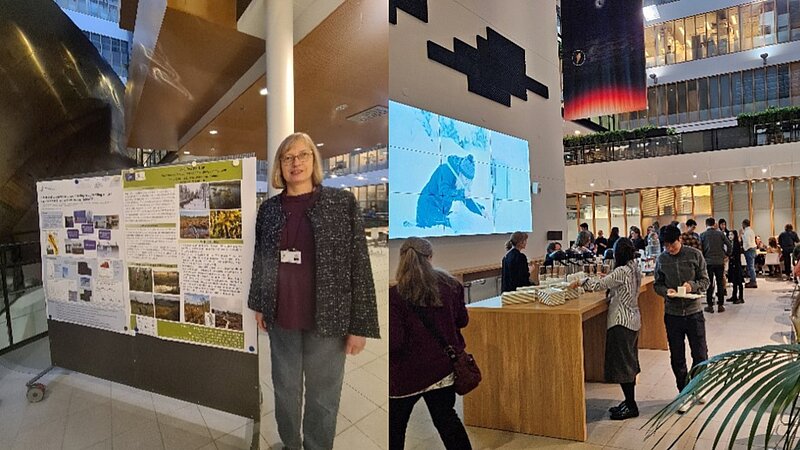
The National Hydrological and Climate Modelling Seminar took place in Helsinki on the 20th of November 2024, bringing together experts from various fields to discuss the latest advancements and challenges in hydrological, ecosystem and climate modelling and water research in general. The seminar provided a platform for scientists to discuss the latest advances and challenges in these interconnected fields. The seminar was organised by the Hydrology division of Water Association Finland, universities, and research institutes.
The focus of the seminar was to explore the role of hydrological, ecosystem and climate modelling in topics related to water resources, resilience and restoration, water cycle in climate, drainage basins and land ecosystems, climate change impacts on the water cycle, extreme events, water cycle interconnections with vegetation greenhouse gas fluxes, soil carbon, nutrients and various chemical compounds relevant to environmental sustainability and protection. These challenges are at the forefront of public discourse, emphasizing the urgent need for reliable, science-based insights to guide sustainable water management, climate adaptation and restoration strategies.
It was inspiring to see top Finnish researchers come together to share their findings and perspectives. Several representatives from across the country, including the LIFE Peat Carbon partners from Finnish Meteorological Institute, the Natural Resources Institute Finland, and the University of Oulu, actively participated in the discussions. Notably, the LIFE Peat Carbon videos were displayed for the audience of >90 seminar participants and FMI employees and guests at the lobby of the FMI building, raising awareness on restoration aims and techniques for forested peatlands.
The National Hydrological and Climate Modelling Seminar provided a wealth of new insights and ideas that will advance future research collaboration in Finland. As climate change continues to challenge our water systems and actions are needed to restore degraded ecosystems, collaboration between scientists remains essential.
Text: Tuula Aalto
Photos: Tuula Aalto, Sari Juutinen
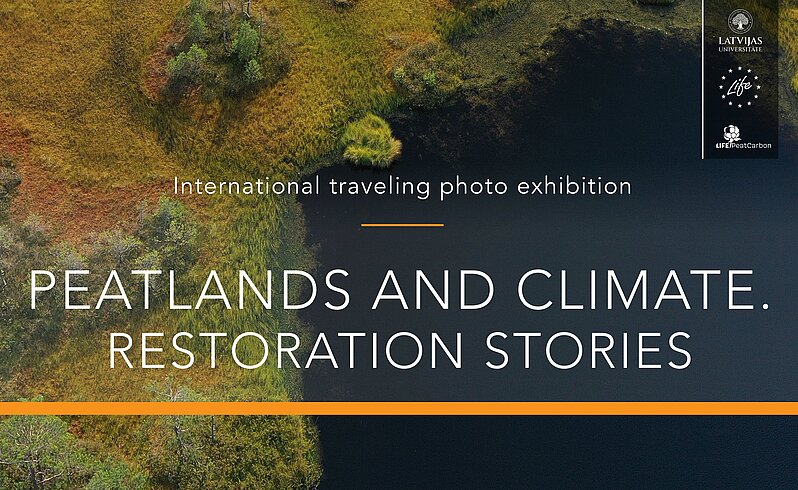
On February 24th at 3.00 PM, the international traveling photo exhibition of the LIFE PeatCarbon project, titled “Peatlands and Climate. Restoration Stories”, will be opened in Riga at the University of Latvia (UL) House of Nature (Jelgavas street 1), featuring works by 20 peatland researchers.
The photo exhibition includes 156 images from seven territories in three countries – Latvia, Finland and Denmark – where, within the framework of the project, peatland habitats are being restored, research is being conducted, and areas of previously restored peatlands with stabilized water levels, where nature is beginning to return, are being assessed.
Peatlands are unique ecosystems that play an important role in nature and in people's lives. Naturally occurring raised bogs are oases of natural diversity and excellent regulators of the water cycle. At the same time, on a global scale, peatlands store more carbon than forests. Drainage of peatlands is one of the factors contributing to climate change, releasing greenhouse gases into the atmosphere (carbon dioxide, methane) which "warm" the globe. Most of Europe's peatlands have been altered by human activity. Many peatlands have been lost irreversibly.
As a result of drainage and peat extraction, peatlands have gone from being sinks of greenhouse gases to sources of emissions. In Latvia, peatlands have also been heavily exploited by human activities. Research shows that the condition of natural peatland ecosystems continues to deteriorate. There is a need for active and immediate protection and restoration of bog ecosystems to reduce greenhouse gas emissions. The LIFE PeatCarbon project is working towards these goals by restoring peatland ecosystems and using nature-based solutions to reduce greenhouse gas emissions at 4 project sites in Latvia – Cena Mire, Lielais Pelečāre Mire, Melnais Lake Mire and Sudas-Zviedru Mire and 2 sites in Finland – Matorovansuo and Välisuo Mires.
The authors of the exhibition's photographs are Rūta Abaja-Felce, Pertti Ala-aho, Anna Autio, Pēteris Āboliņš, Jānis Bikše, Jack Chapman, Jānis Dzilna, Kristaps Ernstsons, Jenni Hultman, Sari Juutinen, Juho Karjalainen, Lauma Ķeire, Krišjānis Libauers, Jekaterīna Matuko, Diāna Nemme, Māra Pakalne, Aivars Petriņš, Aleksi Räsänen, Voldemārs Spuņģis, Līga Strazdiņa, the Municipality of Silkeborg.
We invite you to learn more about the connection between the peatlands and the climate through photo stories! The photo exhibition will be on display on the 1st floor of the UL House of Nature until March 31, after which it will travel to various cities across Latvia for several months.
The photo exhibition has been prepared within the UL LIFE PeatCarbon project. Read more about the LIFE PeatCarbon project here.
Text: Māra Pakalne, Roberts Gorodko
Poster: Lauma Ķeire
The LIFE Peat Carbon project experts from University of Latvia have prepared two new, colourful brochures about the project areas – Cena Mire and Lielais Pelečāre Mire located in Latvia. The brochures will be useful for those who want to get familiar with these prominent peatland areas, to learn more about the natural processes, peatland species and their habitats. The authors have paid also attention to land use history, as it is tightly related with today’s situation in peatlands and other wetlands in these areas. The brochures may serve as a guide for those who want to explore these areas and find out more about peatlands and their relation to climate and biodiversity conservation.
The brochures focus on mires. The main aim of LIFE Peat Carbon project is restoring peatlands to mitigate climate change.
All brochures are available in both Latvian and English.
Brochure on Cena Mire: read and download here
Brochure on Lielais Pelečāre Mire: read and download here
On November 14, 2024, EthnoExpert held its first training session focused on the Verra VCS Program, offering a comprehensive "Step-by-Step Guide to Certification" tailored for the LIFE PeatCarbon project team. The session marked a significant milestone for the project members, as it provided valuable insights into the process of obtaining “Verified Carbon Standard (VCS)” certification for peatland restoration initiatives — an essential step for ensuring their carbon offset projects meet global sustainability standards.
Verra VCS Program: A Global Standard for Carbon Offset Projects
The Verified Carbon Standard (VCS), developed by Verra, is one of the world’s leading programs for certifying greenhouse gas (GHG) reductions and removals. The program helps carbon offset projects across various sectors—including forestry, agriculture, and wetlands—validate and verify their climate impact, ensuring that the carbon credits they generate are both credible and measurable.
Peatland restoration, which is the focus of the LIFE PeatCarbon project, is a critical strategy in addressing climate change. Peatlands are some of the world’s most carbon-rich ecosystems, and restoring them can sequester significant amounts of carbon dioxide while also providing other environmental benefits, such as enhancing biodiversity and improving water quality.
Training Overview: Steps to Verra Certification
The training session was designed to familiarize participants with the VCS certification process, focusing on the specific requirements for peatland restoration projects. It covered a range of topics crucial to obtaining and maintaining VCS certification, including:
1. Initial Requirements for Verra Certification
The session started with an introduction to the basic prerequisites for pursuing VCS certification. Participants learned about the importance of robust project design, rigorous monitoring, and transparent reporting mechanisms, all of which are essential to achieving certification.
2. VCS Project Life Cycle
The training explained the “VCS project life cycle” in detail, which includes the steps from project design and development to monitoring and reporting. This comprehensive overview helped participants understand the ongoing responsibilities involved in managing a certified carbon offset project, as well as the importance of continuous monitoring to ensure carbon sequestration and emission reductions are accurately reported.
3. VCS Methodologies for Peatland Restoration
For peatland restoration projects, Verra has developed specific methodologies to guide project developers in measuring and verifying carbon sequestration. The two most relevant methodologies for LIFE PeatCarbon are:
“VM0007”: This methodology applies to “REDD” (Reducing Emissions from Deforestation and Forest Degradation) projects, including those focused on peatlands. It outlines procedures for measuring and reporting GHG reductions through land-use change interventions.
- “VM0036”: This methodology focuses on “wetland restoration”, including peatland restoration, and offers detailed guidance on measuring and verifying carbon removals in wetlands, which are particularly important for restoring peatlands that have been drained or degraded.
Case Study: “Peatland Restoration Latvia #1”
To enhance the learning experience, the session included a case study of the “Peatland Restoration Latvia #1” project, which is currently listed as “under development” in the Verra Registry. This project, managed by aeco GmbH, was used to illustrate the project listing process within the Verra Registry.
The case study helped participants understand how a project moves from the initial design phase to formal listing and validation. It also provided practical insights into the challenges and steps involved in ensuring that carbon offset projects meet the Verra criteria for carbon sequestration and emission reductions.
Why Verra Certification Matters for Peatland Restoration Projects
Obtaining Verra VCS certification is essential for peatland restoration climate projects, as it provides several key benefits:
1. Credibility and Transparency
Certification under a globally recognized standard like VCS lends credibility to the project and ensures that carbon offsets are accurately measured and reported. This transparency is critical for attracting investors, funders, and stakeholders interested in supporting high-quality environmental initiatives.
2. Market Access
Certified carbon credits are increasingly in demand in voluntary carbon markets, where businesses and governments purchase offsets to meet their sustainability targets. By obtaining VCS certification, LIFE PeatCarbon opens the door to accessing these markets and generating revenue to support further restoration efforts.
3. Environmental Impact
Certification not only helps mitigate climate change but also incentivizes long-term commitment to environmental stewardship. For peatland restoration projects, the potential for significant carbon sequestration makes them a key tool in the global effort to reduce atmospheric CO2 levels and combat climate change.
Looking Ahead: Next Steps for LIFE PeatCarbon
With the training now complete, the LIFE PeatCarbon project team is better equipped to navigate the complex certification process and take the necessary steps toward achieving Verra VCS certification. The next steps will involve finalizing the project design and preparing the required documentation in compliance with the Verra’s rigorous standards.
This training represents a critical step toward scaling up the impact of LIFE PeatCarbon’s peatland restoration efforts. As the project continues to develop, it will contribute to the potential growing body of certified carbon offset projects that help mitigate climate change while restoring vital ecosystems.
Conclusion
EthnoExpert’s training session on Verra VCS certification provided LIFE PeatCarbon project members with the knowledge and tools necessary to successfully navigate the certification process. With the guidance of Verra’s methodologies and the example set by the Peatland Restoration Latvia #1 project, the team is now better positioned to manage and certify their own peatland restoration efforts, ensuring they can deliver both environmental and economic benefits in the fight against climate change.
As the global demand for credible carbon offsets continues to rise, the VCS certification of projects like LIFE PeatCarbon is crucial to driving real, measurable change in the effort to combat climate change.
Text: Igors Semjonovs
Photo: Māra Pakalne
On 26 September 2024, a meeting of the LIFE PeatCarbon Project Steering Group was held, attended by 32 participants representing the Nature Conservation Agency, the Latvian Environmental Protection Fund Administration, JSC "Latvia's State Forests", SIA "Rīgas meži", LIFE "MultiPeat" project and LIFE PeatCarbon project staff. The meetings (Programme) were held both in person at the Science House of the University of Latvia and online.
The Steering group meeting was opened by the LIFE PeatCarbon project manager Dr. Māra Pakalne from University of Latvia (LU) with an overview about the results of the LIFE PeatCarbon project activities in Latvia, which were more in detail presented at the meeting of the Scientific Group by project experts from LU, Institute for Environmental Solutions, State Forestry Institute "Silava" and EthnoExpert. In Latvia, hydro-geological studies have been continued, hydro-geological modelling was carried out for the project areas to assess the impact of the peatland restoration, results have been compiled in the Hydrology Restoration Plans for Lielas Pelečāre Mire and Cenas Mire. The project staff have actively presented the results of their work at various scientific conferences and seminars in Latvia, Finland, Germany, Spain, Estonia and Norway, as well as participated in the LIFE ptalforma Nordic-Baltic meeting in Latvia.
A summary of the progress in Finland was given by Dr. Tuula Aalto from Finnish Meteoorological Institute (FMI), National Coordinator, presenting the results in Finland, which were discussed in more detail in the presentations of the Scientific Group meeting from FMI, LUKE and OULU University (OULU). In winter 2024, the project areas in Finland, Välisuo and Matorova Mires were subjected to peatland restoration measures by felling trees, but in summer dams were built. The restoration results were witnessed by the project staff visit to Finland in July, 2024. Jenni Hultman from LUKE in her presenttaion talked about the peatland restoration experience in Finland. At the project sites in Finland, Eddy covariance towers have been installed for GHG measurements and data is collected using the camera method as well. It is already being concluded that the GHG emissions in the restored areas will be lower than in the degraded part of the project sites.
The meeting continued with a presentation by Indigo Janka from NABU on the publicity activities, including a video of the project and the one about restoration activities in Finland.
The presentation by Marzenna Rasmussen from AMPHI was dedicated to the experience exchange trip to Denmark, during which the project experts could learn about the results of bog restoration in Denmark in LIFE projects, surveying 4 sites - Stenholt Mose, Lille Wildmose, Store Wildmose and Hals Mose, as well as about the possibility of using geomembrane in peatland restoration, which would be a new experience in Latvia if implemented in one of the Latvian bogs. Finally, Igor Semyonov from EthnoExpert provided information on carbon credits and the planned project workshop.
As the presentations and discussions continued at the Scientific Group meeting, the participants learned more about the research carried out on remote sensing, greenhouse gas monitoring, hydrogeological observations, peatland vegetation monitoring and modelling in Latvia and Finland. The project scientific group meeting was opened by Dainis Jakovels from VRI on remote sensing results in Latvia and Aleksi Isoaho on Finland. The next two presentations were devoted to greenhouse gas measurements - Jack Chapmann, Dr. Sari Juutinen from FMI in Finland and Dr. Andis Lazdiņš from Forest research Institute “Silava” in Latvia. Afterwards results of hydrogeological studies at the project sites in Latvia and Finland were presented by Dr. Andis Kalvāns from LU in Latvia and Omar Nimr and Anna Autio from OULU from Finland. Then Dr. Līga Strazdiņa (LU) talked about the monitoring of peatland vegetation in the project sites, focusing on the results in Suda-Zviedru Mire, where the recovery of peatland vegetation can be observed after the implementation of restoration measures in 2017. Kielo Isomäki from FMI presented the results of modelling in Finland. The meeting was closed by Marvin Gabriel, NABU coordinator, who presented the results of the LIFE Multi Peat monitoring.
Text and photo: Māra Pakalne
From September 9-13, 2024, the VIII International meeting on Sphagnum biology was held in Trondheim, Norway hosted by Norwegian Institute for Nature Resrach (NINA) and University Museum (NTNU). In total 53 experts from 3 continents met in to share and build expertise on Sphagnum, the world’s most important peat building plant genus, and gain momentum for global conservation and restoration efforts.
Mire and Sphagnum research has strong traditions in Trondheim, with research in the forefront on both Sphagnum taxonomy (by Kjell Ivar Flatberg) and mire ecology (by Asbjørn Moen) since the 1970’s. Sphagnum is the most important peat building plant genus in the Northern Hemisphere and is essential for ecosystem services and function. The genus also holds the most carbon on a global scale compared to other plant genre. This makes Sphagnum a world champion in a climate change perspective, with peatlands storing more carbon than the tropical rainforests. Despite being irreplaceable carbon storages, both globally and in Norway Sphagnum habitats and peatlands are being lost, mostly due to habitat degradation and exploitation.
The conference included both: presentations and field trips to various peatlands in Trøndelag region of Norway that is a global hotspot for Sphagnum (peatmoss) biodiversity and home to more than 50 species. With a humid coastal climate, the diversity of mire types is unique, providing the foundation that supports species diversity in these ecosystems.
During the Symposium field trips there was a possibility to visit different peatlands starting from fens to raised bogs with a high diversity of rare Sphagnum species. It is due to the Norwegian diversity of mire types which support the species diversity, with mires on different latitudes, in varying topography and in a humid climate with varying level of oceanity. During the four days of excursions, the participants were taken to the mires in Central Norway
both in the strongly oceanic region in the archipelago outside Trondheim, and in the less oceanic parts, the northern boreal parts further inland and at higher elevation.
During the field trip the largest island in southern Norway, Hitra island was visited characterized by anundulating tree-less landscape consisting of coastal heath hills, rocky outcrops, mires and numerous small lakes and brooks, interrupted by a few landmarks of low mountain peaks. Another site included Samsjøen that is a lake and area of, partly protected, forests and mires situated. It was possible to see there the Sphagnum species rare in Latvia, like S. lindbergii and S. pulchrum. The next visited sites were close to Kaldalvatnet. The mires here form flat to sloping complexes with ombrotrophic parts mixed with poor fens. Sphagnum troendelagicum occurs here.
The LIFE PeatCarbon project was represented there by Dr.Līga Strazdina and Dr. Māra Pakalne from LIFE Peat Carbon project with the presentation “Sphagnum species recovery after hydrological regime stabilization in Sudas-Zviedru Mire in Latvia”.
Text and photos: M. Pakalne
The 14th European Conference on Ecological Restoration entitled Bridging Science, Practice, and Policy of Nature Restoration was arranged in Tartu, Estonia, on August 26-30th, 2024. The conference gathered people working on many aspects of ecological restoration. Different ecosystems, including urban ecosystems, had their own sessions. Overall, the topics covered biology, forestry, social sciences, politics, and business. In addition, the conference hosted several workshops and an event for young researchers.
The pre-conference excursions and mid-conference trips offered possibilities to explore Estonia’s nature and included, for example, trips to former peat excavation sites, to the Estonia's largest raised bog Kuresoo, and to Paraspõllu and Kallissaare fens. The sites demonstrated the diversity of peatlands in terms of hydrology and vegetation. In Kuresoo Bog, the dome rises steeply seven meters above the peatland margins, manifesting the power of slow but steady peat accumulation. The alkaline fens are rare wetland types, fed by usually calcium rich groundwater. The precipitation of carbonate minerals on surface forms a calcareous substrate, tufa, and their vegetation is dominated by calciphilous species with low nutrient demand. During the trips, also previously restored wetlands were visited.
LIFE PeatCarbon researchers Annalea Lohila, Tiina Markkanen, and Jack Chapman attended the conference together with colleagues from Finnish Meteorological Institute. They presented observational and model results from forestry drained and rewetted forested peatland’s greenhouse gas dynamics, incl. results from the LIFE PeatCarbon project. An unforgettable conference dinner was held in Ahhaa Science Center. The venue made it possible to have dinner and socialize but also explore the exhibits.
The conference gave a lot to take home. For example, the experiences from restored sites and different Estonian peatland types. It was inspiring to learn about ambitious restoration projects elsewhere and about the development of current restoration legislation.
From September 16 to 18, 2024 Baltic Networking Meeting brought together LIFE programme project representatives and National Contact Points in Riga, Latvia. This event brought together over 100 participants, representing nearly 40 different LIFE projects from Estonia, Latvia, Lithuania, Denmark, Sweden, and Finland.
The meeting, aimed at LIFE and LIFE IP Nature project promoters, focused on engaging stakeholders, providing a platform for knowledge sharing and networking. Representatives from the European Executive Agency for Climate, Infrastructure and Environment (CINEA) and ELMEN were also present, providing an invaluable opportunity to network with key players in the environmental sector.
The event included excursions to explore different protected sites and hands-on activities related to nature conservation and environmental management. The excursions were led by experienced professionals and were an excellent opportunity to learn more about nature conservation projects in the region.
LIFE PeatCarbon project participants had the opportunity to take part in an exciting opportunity to explore the remarkable natural areas of Western Latvia and practical examples of nature conservation. Participants visited several local sites where LIFE projects are being implemented to restore natural habitats and conserve biodiversity.
The main stops of the excursion were:
1.Dundurpļavas near Tukums
The tour starts at Dundurpļavas, where the LIFE+ Hydroplan project focusing on wetland restoration is being implemented. Here, participants saw the restored meanders of the Skudrupīte River, an important initiative to improve the condition of local waters and maintain their natural flow.
In addition, participants had the unique opportunity to observe a herd of wild cows in their natural habitat. Wild cows are used to maintain grassland habitats, helping to promote natural diversity, reduce overgrowth and maintain ecologically valuable habitats.
2. Visit to the Abava River Valley
The tour then took participants to the Abava River valley, where they were introduced to the eradication measures for the invasive species Solidago canadensis (Canadian goldfinch). This is an important effort to protect native plants and maintain the balance of nature in this ecologically sensitive area.
3. Innovative forest management and restoration techniques
During the excursion, participants learnt about innovative forest management methods that are being introduced to conserve the valuable forest habitats of Western Latvia. They were also shown sustainable agriculture solutions used in Drubazi, where farmers work in close cooperation with environmental specialists to reduce the pressure of agriculture on natural resources and protect the surrounding ecosystems.
4. Visit to Lake Kaņieris - Natura 2000 site
At the end of the excursion, the participants visited Lake Kaņieris, a Natura 2000 site. Lake Kaņieris is an excellent example of the implementation of nature conservation objectives in Latvia, and participants were able to learn more about the specific nature conservation objectives of Natura 2000 and the measures taken to protect these unique natural values.
The tour "Examples of Nature Conservation in Western Latvia" provided a comprehensive overview of Latvian nature conservation initiatives and offered participants the opportunity to see practical examples of how natural ecosystems are being restored and innovative management methods implemented.
More about the event https://latvianature.daba.gov.lv/en/news/latvianature-gives-an-insight-in-the-project-at-the-nordic-baltic-life-platform-meeting/
Photos: Marada Katrina Eihe, Māra Pakalne
On June 6, 2024, the projects LIFE Multi Peat and Peat Carbon hosted an online workshop on the methodological aspects of carbon credit verification standards. Experts from both projects, and the Dutch programme, Valuta Voor Veen, discussed how landowners can effectively sell carbon credits from peatlands. Since there is still much lack of knowledge, suspicions, and downright confusion surrounding this topic, Rewilding Europe was invited to introduce the process, showing participants how they work with landowners to sale carbon credits.
As a project developer, the Rewilding Europe Foundation aims to make rewilding a financially competitive land use, showing that it has investment potential and, above all, enabling restoration on a large scale with benefits for local communities. The Foundation is already helping University of Galway, the Multi Peat partner in Ireland, develop carbon credits from their peatland site. This initiative may lead to the first sale of carbon credits from peatlands in Ireland.
Carbon Credit Verification standards
During Rewilding Europe’s presentation, we learned that to develop carbon credits from a peatland area, a carbon credit verification standard must be applied. There are regional, national, and international standards, which set the framework that will guide the landowner from the beginning until the sale of the carbon credits generated; the process includes preparatory work and planning, establishment of a baseline, the actual restoration, as well as the continued monitoring of the site after implementation. Basically, the standard regulates the rules surrounding measurement, reporting, and verification of the carbon credits.
Which standard is chosen may depend on whether the country where the site is located has developed their own standards. Many countries are developing national or regional standards; for example, Germany’s states of Brandenburg, Mecklenburg-Western Pomerania, and Schleswig-Holstein have Moorfutures. Netherlands and the United Kingdom have recently developed Valuta Voor Veen and UK Peatland Code, respectively. At the international level, the Verra standard is one of the most recognised. The white paper from the project Interreg Care-Peat provides a great overview and analysis of the various applicable standards.
From the perspective of the landowner, following the standards can be complicated and expensive, moreover, the financial return is uncertain, as it depends on carbon prices and the natural features of the site, for example, the level of degradation. Indeed, many aspects need to be considered to have an eligible site, whereby GHG reductions can be verified and sold as carbon credits. These may vary according to the applied standard but will, generally, address land ownership structure, allowed activities within as well as surrounding the site, criteria for peatland definitions, and several other important elements that were discussed by Rewilding Europe in the presentation, like monitoring requirements to establish baseline and future scenarios.
More information https://multipeat.org/en/blog/carbon-credits-peatlands-exchange-experience-rewilding-europe
Text: Leticia Jurema
Photo: Māra Pakalne
The 20th International Mire Conservation Group (IMCG) Field symposium "Peatland Conservation, Restoration and Paludiculture" was held from 26 July to 4 August 2024 in Germany. It brought together over 30 peatland experts and enthusiasts from 17 countries, like Australia, New Zealand, UK, Portugal, Switzerland, France, Germany, Norway, Latvia, The Netherlands, South Africa and Malawi.
The IMCG, an international network of experts, dedicated to promoting and encouraging the conservation of mires and related ecosystems, while also facilitating the exchange of information and experiences globally. With over 550 contacts in nearly 60 countries, the network plays an important role in peatland conservation and restoration.
The programme took the researchers to peatlands from the south to the north of the country, including intact peatlands with unique biodiversity, restored peatlands and rewetted areas used in paludiculture.
German peatlands, though covering a relatively small area, hold significant global ecological and environmental importance. Alarmingly, degraded peatlands account for 7% of Germany’s total greenhouse gas emissions, making them a major contributor to global peatland emissions. Drawing on expertise from across the globe, through observation, discussions, and exchanges with local experts during the excursion, participants drew up recommendations for peatland conservation and restoration in Germany and the European Union.
Travelling from southern to northern Germany, the IMCG experts explored a variety of peatlands, including some of the best-preserved areas in Germany such as the Pfrühlmoos in Bavaria. As the group travelled north into the lowlands, they encountered deeply degraded sites, areas of ongoing peat extraction, and promising locations where renaturation efforts are beginning to show success. Sites putting paludiculture into practice were visited, such as Sphagnum farming in Hankhausen (Lower Saxony), Typha fields in Neukalen (MV), and the wet meadows of the Klimafarm in Schleswig-Holstein—demonstrating the broad potential of paludiculture.
Further stops included the Freisinger Moos (Bavaria), the Hannoversche Moorgeest and the Eider-Treene-Niederung (both in Neidersachsen) the Peene Valley in Mecklenburg-Western Pomerania and “Hannoversische Moorgeest” LIFE Project. It includes four raised bogs that include unique values of Lower Saxony.
At the IMCG Symposium Latvia was represented by the LIFE PeatCarbon project manager Dr. Māra Pakalne who presented a poster about the activities and results of the LIFE Project.
Text and photos: M. Pakalne
From July 1-3, 2024 the LIFE PeatCarbon project team in total 14 members had a unique possibility to participate in the peatland restoration work carried out in Pallas region in Lapland where the two project sites - Matorova Mire and Välisuo Mire are located. The trip was hosted by the research team from Natural Resources Institute (LUKE) in Finland (Dr. Jenni Hultman and Dr. Päivi Mäkiranta), Finnish Meteorological Institute (Professor Annalea Lohila and Jack Chapman) and University of Oulu (Dr. Anna Autio). From University of Latvia participated the project manager Dr. Māra Pakalne and national coordinator Pēteris Āboliņš, Aija Vanaga and Elīna Konstantīnova from “Baltic coasts”, Agne Šusta and Gints Šusts from LTD. “AGS systems”.
Already at the first evening there were lots of discussions on the restoration status of project sites in Pallas and Latvia. In Finland restoration in the project sites is carried out by Metsähallitus, but beforehand all the work process was discussed with Jenni Hultman from LUKE, together with representative from Metsahällitus, Minna Lalli. The status of restoration work was checked beforehand. The tree logging had been finished and the excavator was already at the project sites ready to start the building of dams.
Firstly, Välisuo peat forest at the Pallas Atmosphere-Ecosystem Supersite was visited. Together with Metsähallitus representative Minna Lalli greenhouse gas measurement sites were checked and the restoration process observed. There was lot of discussion on the restoration actions, rationale for them and possible differences between sites in Finland and Latvia. Dr. Anna Autio from University of Oulu showed the hydrology measurement devices and explained the different measurement strategies used. She also described the movement of the surface and ground water and how the restoration actions will be affecting these. Jenni Hultman from LUKE explained the setup of monitoring plots along the boardwalks. The greenhouse gas (GHG) and microbiology measurements, as well as vegetation surveys, are conducted in the same plots. In Finland GHG gases, like carbon dioxide, methane and nitrous oxide are measured every two weeks during snow free period and once a month during snow season. Samples for microbial activity and processes were collected before restoration, right after restoration and next set will be taken in 2026.
Matorova Mire with the Eddy covariance tower was the second site to visit. The differences between drained and more pristine areas could be easily seen from the boardwalks. Jack Chapman from FMI described us the research within the recently built EC tower measuring the greenhouse gases in the LIFE PeatCarbon study sites. During the visit the group also visited other research sites and measurements stations Pallas ecosystem supersite with Annalea Lohila. These included Lompolojänkä Peatland sites which is an ICOS Ecosystem station, Kenttärova, ICOS associated ecosystem station and ICOS station Sammaltunturi.
At the end of July 2024 over 100 dams were already built and the water table has clearly risen. The logging residue deposited to the blocked ditches will slowly start degrading.
The first after restoration measurements are started and will be continued to follow the effect on hydrology, greenhouse gas emissions, vegetation and microbial metabolic processes. It was also possible to observe cloudberries ripe and delicious during the excursion which is the symbol of the project.
Text: Jenni Hultman
Photos: Jenni Hultman, Māra Pakalne
Peatland restoration can be limited by a lot of factors and although practical concerns of land accessibility, technical limitation and finance are often at the forefront – culture plays an equally important role when it comes to restoring peatlands yet is rarely ever touched upon. It is culture that shapes our relationship with nature, our culture teaches us how to perceive the world, what references to base our default setting on and gifts us a language to make sense of it.
So, it is no big surprise that cultures with a kinship relationship to nature have a different language to describe it. For instance, the Potawatomi acknowledge the agency of water using verbs to describe the state it takes, wiikwegamaa means to be a bay. Thereby the language recognizes not only the agency of nature but also the fluctuating state of water, it might be a bay at one moment, a river the next day and become the ocean after that, all of which are verbs in Potawatomi (Robin Wall Kimmerer, p.55). In comparison, most European languages consider a sea or lake as something static, an object that in terms of linguistics is no different than a car or book. In the English language, you have two choices: You are either human or you are a thing. The language in this case makes it profoundly difficult to express agency, animacy and a sense of connection to nature, as in terms of linguistics nature it is dead. The influence this grammatical question has on nature conservation, should not be overlooked. Imagine a discussion on protecting certain ecosystems in a language that acknowledges nature as alive with its own agency. Or a discussion on protecting peatland ecosystems, whose names have been lost. They would be profoundly different, even if held amongst the same set of people.
It can safely be stated that our language reflects our culture, omissions of words in our language are revealing our culture and the lack of a perceived need for naming something. Although this is all interesting, you may wonder: How is this connected to peatlands in Denmark?
The Danish language does not differentiate between different types of peatlands. So it happens that a bog, a mire, a raised bog, fen, etc. all are called Mose. Although this might seem to be a neglectable detail – this deficit in names tells you most you need to know about Danish peatlands. They have been depleted by 95% - converting them into ‘useable’ land, which for a country that is second only to Bangladesh in terms of agricultural land coverage means farmland. Many Europeans assume that Denmark has a lot of nature. Yet, flying into the country the bird-eye view will tell a different story, this is a country that has optimized agricultural usage of land for over 100 years, and they effectively plan to use 140% of their land (double usage is a pre to even to consider this). This leaves very little space for nature.
The language reflects this, similarly to the habitats the words are missing - they disappeared. It is very complicated to restore something that is degraded, but restoring something that even lost its name is the end boss of restoration if you’d like. You have the practical concerns that require taking back physical space, making it "unproductive" (in the strict economic sense of a capitalistic system) and inviting nature back to places that are almost completely abandoned. Doing all of this, without influencing the surrounding farmlands would be difficult enough – but you must do this, in a culture that does not have the words to describe what you try to invite back.
Whereas in terms of landscape-level restoration the Danish sites will not add hugely to the European hectare count, they do something else. The environmentalists fearlessly experiment with what they have been given. Supported by Aage V. Jensen Foundation, their active approach to management seeks to broaden the toolbox for nature conservation.
On a European level often a lot of effort is spent conserving peatlands and restoring slightly degraded sites. While these efforts are important, the Danish try to bring nature back where it was lost hundreds of years ago. They are, if you’d like, in a different game, it can hardly be called restoration, as the extent of the degradation they have started from leaves little to restore. Yet the Danish colleagues took up the task, experimenting with membranes to influence water levels, and imported sphagnum to jump-start peat formation and grazing to control invasive species. With this, they offer a valuable approach to conservation, as solutions they will undoubtedly discover through trial and error will influence more than just their sites. It will allow for the replication of methods, bringing back nature in other spaces we thought her to be lost. And who knows? Maybe with nature making a comeback, the words will follow. They might even be verbs, underlining the state the peatland has currently taken and acknowledging the agency of nature.
Text: Indigo Janka
Photo: Māra Pakalne
From May 13 – 16, 2024 LIFE Peat Carbon project partners convened in Denmark for a study tour organized by Amphi International ApS and Silkeborg Kommune.
The study trip started with the setting of the context through various presentations concerning Danish Peatlands. This general information about their history, current condition, recovery projects and monitoring allowed all participants to start the excursions, which took place over the following days with the same background knowledge. It quickly became clear that Denmark's peatlands have been under severe pressure through agricultural use and restoration projects need to go to considerable lengths to have a positive impact. During the various excursions to Stenholt Mose, Lille Vildmose, Store Mose and Hals Mose different restoration approaches were highlighted. Whereas in Stenhold Mose the use of membranes for hydrological management was highlighted, Lille Vildmose was a case study of the management of an area with the help of large grazers. The next day in Hals Mose, the participants learned that most of the cataloguing was done in a bio blitz with many nature enthusiasts and biologists cataloguing for one day. In Store Vildmose a membrane was placed by hand, followed by a flooding of the area to drown unwanted birch tree growth.
It can be concluded that the study tour was a very diverse showcase of peatland restoration practices in Denmark, highlighting various approaches all tailored to the local context and challenges.
More information about the 4 Danish peatlands visited, located on Jutland peninsula here:
a) Stenholt Mose (https://eunis.eea.europa.eu/sites/DK00DY294 )
b) Lille Vildmose (https://eunis.eea.europa.eu/sites/DK00FX125 )
c) Store Vildmose (https://eunis.eea.europa.eu/sites/DK00FX120 )
d) Hals Mose (https://naturfonden.dk/natur/hals-mose/ )
On 10 to 11 April 2024, LIFE Platform Meeting on Soils was organised in Pamplona, Spain where soil experts and stakeholders shared insights and learnings on soil conservation, contamination and management.
The European Executive Agency for Climate, Infrastructure and Environment (CINEA), the European agency that manages the European Commission's programs that contribute to decarbonization and sustainable growth, has chosen the capital of the Chartered Community of Navarre, Pamplona, as the venue for the LIFE platform meeting on the theme of soil.
The LIFE Platform Meeting on Soils, co-organised by LIFE NAdapta and LIFE IP Urban Klima 2050, was a two-day event that aimed to foster networking, feedback, and policy input among the stakeholders involved in soil-related projects funded by the LIFE Programme. About 50 projects participated, among them LIFE PeatCarbon project represented by the project manager Dr. Māra Pakalne and project expert geologist Dr. Andis Kalvāns who in a poster presentation oulined the project ideas and results.
The meeting covered three main soil sectors: conservation and adaptation, contamination and bioremediation, and management and mitigation. This event was designed to identify the most significant contributions that the LIFE Program or other European programs (Horizon Europe, Interreg) can provide to achieve the objectives set by the new law and support its implementation.
Soils are crucial for biodiversity, food and economy and deserve the same level of protection as, to varying degrees, water, air, the terrestrial environment or the marine environment, for example. The LIFE program has funded several projects addressing soil issues in different sectors. From the analysis of the projects previously approved, and ongoing, it is possible to identify the main sectors or themes, or areas of work into which projects could be grouped for a LIFE platform meeting on soil, and they are: 1) Soil conservation and adaptation to climate change (including the urban context) 2) Soil contamination and bioremediation 3)Soil management in the agricultural sector.
The participants also discussed horizontal topics such as climate change, promotion of soil literacy, economic opportunities, and water-soil nexus. In addition, the attendees were invited to share their professional experience, as well as the challenges and best practices for implementing the EU Soil Strategy and the upcoming Soil Directive.
Photo Māra Pakalne, Marvin Gabriel
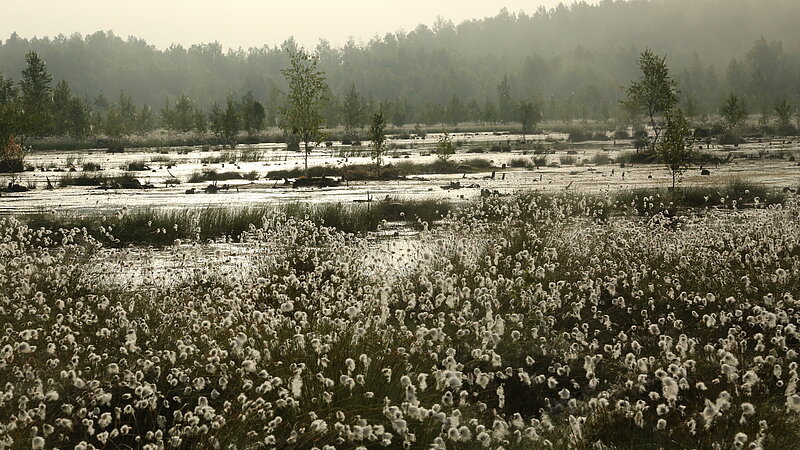
The peatland post documents our shared journey towards restored and protected peatlands. As a group of peatland-related LIFE projects, we came together to create the Peatland Post to gather our shared progress and celebrate our small and big wins. The quarterly newsletter will provide you with project updates and peatland policy-related news. Sign up – we will make it worth your time.
The 5th peatlands day organised by the Finnish Peatland Society took place in Helsinki on the 5th of April, 2024. Through its activities, the society promotes multidisciplinary research on Finland’s peatlands, and sustainable management of their ecosystems. The theme of the seminar was to investigate peatlands as the moderators and accelerators of environmental transitions (e.g. climate change, biodiversity loss). Similar polarization is often brought up in public discussion, and there is an urgent need for reliable knowledge on the best practices to mitigate environmental degradation on peatlands. It was great to see the top peatland scientists in Finland come together, and discuss the perspectives found in their research.
Several LIFE PeatCarbon project members from Finnish Meteorological Institute, Natural Resource Institute Finland, and University of Oulu took part in the seminar, and Jack Chapman presented the first measurements from Matorovansuo restoration site – a LIFE PeatCarbon study site located in Northern Finland – in a poster. The measurements taken in Matorovansuo during the first year were taken prior to the restoration and will later serve as the reference data for assessing the impacts of the restoration. The data includes, e.g., greenhouse gas flux measurements and peatland vegetation analysis.
Three significant issues were identified throughout the seminar:
- Peatland ecosystems are diverse and their responses to environmental change are not yet fully understood despite many field studies and measurement campaigns. More efforts are needed to understand the main processes on different peatlands, and to further develop process-based models. Through process-based modelling, we could better assess large-scale impacts and scenarios of peatland management.
- A large proportion of peatlands in Finland are heavily managed (drained) and provide ecosystem services (agriculture and forestry) to the landowners and society at large. How can we reconcile emission reduction targets, ecosystem conservation and economic benefits from these areas?
- Several comments reminded us that releasing carbon from the peat soil is a fundamentally different process than storing the same amount of carbon to vegetation. Pristine peatlands can store carbon permanently if the water level in the peatland is kept above the peat layers, whereas CO2 stored in tree biomass is generally released back into the atmosphere within decades.
The peatlands day provided new insights and ideas that will be further developed during the LIFE PeatCarbon project. Work continues!
Text: Kielo Isomäki.
Photos: Tuula Aalto
Restoration Plan for the Finnish LIFE PeatCarbon project sites in Pallas, Välisuo and Matorovansuo Mires (68◦ N; 24◦14’ E.), was finalized and approved in late 2023 with the Finnish authority Metsähallitus (Finnish Forest and Park Service, https://www.metsa.fi/en/) who is responsible for the actual restoration work conceived in 2024. The sites have been described in detail at the LIFE Peat Carbon webpages (https://www.peatcarbon.lu.lv/en/project-summary/finland/project-sites/).
Figure 1. Location of the restoration sites and their catchment areas. Matorova Mire is marked on grey dashed line and Välisuo Mire with red dashed line.
The two mires were drained in 1960-ties and 1970-ties for forestry and the restoration aims to return the ecology of a pristine peatland in the area. These large peatland areas were drained at least on the edges, which has affected the hydrology of the peatland and vegetation also in their undrained central parts. The planning process included a substantial amount of planning and fieldwork to achieve the best possible knowledge, for example about the drainage paths and present conditions of the ditches. Black-and-white aerial photographs taken in 1957, with a coarse resolution, were used to assess the condition of the sites before the drainage. In addition, aerial photographs from 1996, 2004, 2012 and 2018 were used together with field surveys to assess the natural state of the sites.
Peatland Restoration Plan includes measures for both rewetting and tree harvesting by returning the original tree biomass. The targeted plan for tree harvesting is conducted in winter 2024 and area with benefitte dwarf birch Betula nana will be harvested. The trees that have survived from the pre-drainage are identifiable
Undrained and drained pine flark fens in Matorovansuo Mire restoration area and the benefitted dwarf birch Betula nana areas.
Rewetting will be conducted through ditch blocking (dams and filling) and via directing water to the peatland (Fig. 3). The goal is to restore the water balance of the mires and their various parts as close as possible to the condition that prevailed before the drainage. The task is to return the water flows coming to the mire and moving between different parts of the sites to the conditions before the drainage. The water flows leaving the areas are slowed down (however, not completely blocked) and, if necessary, directed to the way they were estimated to be before the drainage. In addition to using peat to fill the ditches dams will be built from the harvested trees. Combination of peat and three logs will also be used.
Figure 2. Example of plans for building wood dams (PP), peat dams (TP), filling the ditches (OT) and directing water to the peatland (VOS) from southern part of Matorova Mire.
Restoration is put into practice during winter-summer 2024. We have marked all the area where heavy machinery cannot be used, including our monitoring instruments and sites as well as the board walks built for LIFE PeatCarbon monitoring work. After snowmelt rewetting will be conducted with two above mentioned routes: through ditch blocking (dams and filling) and by directing water to the peatland.
Photos Timo Penttilä.
In response to the invitation from the Embassy of Ireland in Latvia to introduce the Irish Minister Minister of State at the Department of Agriculture with responsibility for Land Use and Biodiversity Pippa Hackett to tell about the peatland protection and management of in Latvia, on 18 March Dr. biol. Māra Pakalne had an opportunity to guide the Minister to the project's study area - Cenas Mire, an specially protected nature reserve in Latvia. The excursion was attended by the Ambassador of Ireland to Latvia Eimear Friel, adviser to the Minister Declan O'Rourke, Private Secretary to the Minister Jacquie Casey and Deputy Head of Mission at the Irish Embassy Chris Boyle, as well as representatives from the Ministry of Agriculture and "Rīgas meži" Lt. The University of Latvia was represented by the LIFE PeatCarbon project expert in geology Dr.geol. Andis Kalvāns and project coordinator Pēteris Āboliņš.
During the meeting, LIFE PeatCarbon project manager Māra Pakalne introduced with the biodiversity of Cenas Mire, its role in climate regulation, carbon sequestration and global warming mitigation. Particular attention was paid to the raised bogs found here, whose distribution has been significantly reduced in large parts of Europe as a result of human activities. Latvia's raised bogs are therefore of considerable importance in the European context and are a priority habitat for protection in the European Union. The area of natural raised bogs in Latvia is also declining. The question of how to restore bogs is therefore a pressing issue both in Latvia and in Ireland. Māra Pakalne, the project manager, talked about the experience of the project in peatalnd restortaion in Cenas Mire. Minister Pippa Hackett was particularly impressed by the results of raised bog restoration in the area of Skaists Lake, as she had not seen such results before. The measures taken to protect the raised bog have reduced water run-off from the site. As a result, pine trees, which developed largely as a result of the drainage of raised bog, have started to die back. The raised bog is thus approaching its original, natural situation with a slight woody plant cover. Discussions at Skaists Lake were sparked by the particular issue in Ireland of restoring bogs where they border farmers' properties. Restoring bogs reduces greenhouse gas emissions from bogs in the long term, as the water level rises and the bog's characteristic plants become established. However, it is almost impossible to restore the original bog vegetation and its structure with the micro-relief of open water pools, hummocks and hollows. These raised bog conditions have developed over thousands of years as a result of interactions between vegetation and climate. It is particularly difficult to recreate bog conditions in open peat fields after peat extraction has ceased, as the climate today is not as suitable for raised bog development as it was thousands of years ago.
Walking along the nature trail of the Cenas Mire, Minister Pippa Hackett listened with interest to the most important plants of the mire, including Sphagnum moss, which is the main peat-former. Discussions with the Minister revealed that although there are raised bogs in Ireland and Latvia, they are very different, both because of the climatic conditions and because of the nature of their formation. The Minister mentioned the Clara Bog in Ireland, where significant restoration work is being carried out to prevent erosion and the effects of drainage, while working with local people. The LIFE project manager, Māra Pakalne, also had the opportunity to visit this bog, which facilitated an interesting exchange of experiences on bog conservation. The project expert Andis Kalvāns talked about the hydrological studies in the Cenas Mire, and also mentioned the greenhouse gas measurements in the site by the project beneficiary Forest Research Institute "Silava". The Minister was also interested in the role of the partners in the project, which now totals 12, with 4 countries - Latvia, Finland, Germany and Denmark.
The Irish Minister Minister of State at the Department of Agriculture with responsibility for Land Use and Biodiversity, Pippa Hackett, praised the work of the LIFE PeatCarbon project team and the added value of the project for nature conservation. She said she was particularly impressed by the results of the restoration of the Cenas Mire and by the extensive natural landscape of the raised bog, which could be seen from the watching tower.
The day after the visit of Cenas Mire, at a reception organised by the Irish Embassy, Minister Pippa Hackett expressed her gratitude to the University of Latvia LIFE PeatCarbon project team for the opportunity to visit Cenas Mire and learn about Latvia's leadership in the conservation and management of the mires.
More information about the LIFE PeatCarbon project at www.peatcarbon.lu.lv
Information prepared by M. Pakalne, tel. 29511001, e-mail: mara.pakalne@lu.lv
How does the restoration of forestry drained peatland affect the carbon and water cycles, vegetation, and microbial communities in LIFE PeatCarbon project study sites? This is being investigated in a project near Pallas-Yllästunturi National Park in Matorovansuo and Välisuo peatlands in Finland.
Peatlands depend on water, and restoration aims to raise the water level back to its natural level. The goal is the recovery of northern fen environments and the return of diverse, partly endangered species. Raising the water level is vital to prevent the decomposition of old peat and the release of carbon into the atmosphere, while enabling the accumulation of new peat and carbon.
Some of the trees in the area are being cut down, and the trunks and logging residues are used to block the ditches, deviating from the established peatland restoration method of Metsähallitus, where the ditches are filled only with peat. This is done to restore the original tree density and maintain the subsurface water flow typical of northern fens. Logging residues slow down the water flow, and the released nutrients promote microbial activity, which will form a biofilter and reduce nutrient leaching into downstream waters. Wood biomass in peat increases soil carbon storage.
Peatland restoration is part of the LIFE PeatCarbon project, funded by the European Union from 2022 to 2027 and coordinated by University of Latvia. Finnish partners in the project include the Finnish Meteorological Institute, the University of Oulu, and the Natural Resources Institute Finland, as well as Metsähallitus, which carries out the peatland restoration measures. Other project partners are from Denmark, Germany, and Latvia.
Changes in greenhouse gases and vegetation are being investigated through joint research
The Finnish Meteorological Institute and the Natural Resources Institute Finland measure greenhouse gas fluxes (carbon dioxide, methane, and nitrous oxide) in the restored areas before and after restoration. This allows the quantification of the impact of restoration on peatlands immediately in the first years after the intervention. Continuous micrometeorological eddy covariance measurement is one of the state-of-the-art measurement methods used.
"It is expected that restoration will quickly lead to changes in water conditions and greenhouse gas balances, but changes in vegetation will take longer to become apparent. The Natural Resources Institute Finland is studying the effects of restoration on the area's vegetation and microbial communities by measuring them before and after restoration. Remote sensing methods play an important role," says Senior Researcher Jenni Hultman from the Natural Resources Institute Finland.
Microbes are studied using precise sequencing methods that provide information not only about species but also about microbial functionality. Functions related to greenhouse gas cycles are of particular interest.
Greenhouse gas measurements are used to support modelling of greenhouse gas budgets. Researchers from the Finnish Meteorological Institute are modelling the effects of restoration on the area's greenhouse gas balances and peat carbon storage decades into the future.
"Simulations seek to answer questions such as how climate change affects greenhouse gas balances and soil water conditions, and how fast peat accumulates. These questions will be answered by models that accurately describe peat and vegetation processes," says Principal Scientist Tuula Aalto from the Finnish Meteorological Institute.
The study is part of the Finnish Meteorological Institute's long-term research activities in the Pallas region.
The mysteries of soil water are being investigated using a variety of methods and combined with modelling
A research group at the University of Oulu is studying how restoration changes the hydrological conditions in the area.
"When the ditches are blocked, where will the spring melt water go? Surface water flows are expected to become more uniform, and as the groundwater level rises, greenhouse gas emissions are expected to decrease. We are building models of these effects on the catchment water system, which will allow us to assess the effects of restoration up to 50 years into the future," says doctoral researcher Anna Autio from the University of Oulu.
To refine their models, researchers from the University of Oulu carry out wireless monitoring. Ground-penetrating radar surveys are also carried out in the spring. The measurements determine the thickness of the peat layer and soil structures, such as rapidly permeable sand layers, to determine where water goes or stays. Modelling is being developed so that the effects of restoration in other areas can also be assessed using these models.
The University of Oulu's research in the Pallas region is part of projects funded by the Academy of Finland and the EU, as well as the flagship project Digital Waters.
The Matorovansuo and Välisuo peatlands are one of the northernmost restoration sites in the world, where the effects on hydrology, greenhouse gases, vegetation, and microbiota will be closely monitored in the coming years.
For more information:
Tuula Aalto, Principal Scientist, Finnish Meteorological Institute, tel. 029 539 5406, tuula.aalto@fmi.fi
Anna Autio, Doctoral Researcher, University of Oulu, Water, Energy and Environmental Engineering Research Unit, tel. 045 858 6958, Anna.Autio@oulu.fi
Jenni Hultman, Senior Researcher, Natural Resources Institute Finland, tel. 029 532 2798, jenni.hultman@luke.fi
In 2024 the annual Scientic Conference of the University of Latvia takes place already
the 82 nd time. (https://www.konference82.lu.lv/) Traditionally the conference is
organized in several science blocks, including Natural Sciences, comprising a wide range
of themes from many research directions. At the Conference the LIFE PeatCarbon
project team introduced their research results and future plans.
The first presentation was delivered on February 8 at the Plant Breeding and
Introduction session of the Botanical Garden of the University of Latvia, dedicated to the
problems of creating and maintaining living plant collections, theoretical and practical
aspects of plant breeding, as well as plant tissue cultures, research in plant physiology
and biodiversity conservation. Līga Strazdiņa introduced the Habitat of the Year 2024 –
Wetlands, which also includes mires
(https://conferences.lu.lv/event/409/attachments/412/1091/Programma.pdf). On a
global scale, protection of wetlands is provided by the Ramsar Convention. Within the
framework of EC LIFE Programme and other funding programs, experts of the University
of Latvia Botanical Garden have contributed to the preservation of biological diversity
and the restoration of degraded habitats in three internationally important Ramsar sites
– Nothern Bogs, Lake Engure, as well as Teiči and Pelečāre Bogs, which is the LIFE
PeatCarbon project site. As part of the project, it is planned to install a new Mire
exposition at the Botanical Garden of the University of Latvia. Therefore, in the
conference, examples from other botanical gardens of the world were shown, where
similar expositions are also installed. Promoting public education about wetlands and
the plants found in them will improve understanding of the need to preserve natural
values, as well as understanding the goals of the LIFE program.
On February 16. Another seesion of the 82 nd University Scientifoc Conference took place
under the title “Changes in the dynamics of bog development under the influence of
natural conditions and human activity”, organised by the faculty of Geography and Earth
Sciences.
The Conference session was devoted to the actual peatland development and
management problems. The Programme included 19 presentations and a poster. The
peatland renaturalisation and recultivation possibilities were discussed, importance of
the study of paleovegetation and geology, model for peatland restoratation was
demostrated and the role of paludiculture stressed. It was stressed that there are
various information about the peatland area in Latvia that gives evidence to the lack of
recent peatland inventory.
At the Peatland session there were three presentations from LIFE PeatCarbon project
experts. Dr. geol. Andis Kalvāns expert in geology from University of Latvia talked about
the methodology for planning of hydrological restoration of drainage impacted raised
bogs, referring to the examples of Lielais Pelečāre Mire and Cena Mire. The
methodology includes GIS data base that includes various data sources, like, geological,
topographic and habitat maps, as well data created during the project – the precise
location of drainage network, ditch location and peatland deposit evaluation,
georeference photo acrhive. In the next step of the work the possible locations of the
dams will be identified on all the ditches in the territoe=ry of the Lielas Pelečāre Mire.
After that in the joint expert meetings the most effective ways of peatland restortaion
will be determined.
The results of hydrogeological modeling for the evaluation of the peatland restoratation
effect in Cena Mire and Lielais Pelečāre Mire were presented by modeling expert from
the University of Latvia Andrejs Timuhins. The three layer model is based on MODFLOW
program. As a result of modeling, the static water level for both the mire scenarious for
the time period from 2008 to 2018 with and without dams on drainage ditches were
obtained. The effect of raising of water level by building of dams was analysed. Insipte
to that fact that the analysis is based on the non-calibrated model, the model
qualitatevely reveals the natural processes in both the mires and allow the evaluation of
the effect of the stabilization of site hydrology.
The project manager and mire expert from University of Latvia Dr. biol. Māra Pakalne
informed about the vegetation change after carrying out restoration measure by raising
of water level in Sudas-Zviedru Mire. The study of the area started already within the
previous LIFE Wetlands LIFE13 NAT/LV/000578 project.
In Sudas-Zviedru Mire with the total area of 2575 ha hydrological and vegetation studies
were carried out and vegetation monitoring plots set up in 2015. To stabilse the site
hydrological regime, in 2017 in total 67 peat or wood dams were built. Mire vegetation
monitoring was carried out in 2015, 2016, 2018, 2020 and 2023 before and after raising
of water level. In the next vegetation period rising of water level, immediate changes
were observed, including the re-appearance of Sphagnum cuspidatum in the drainage
ditches and nearby area. Still, 5 years after the start of restoration, the vegetation in
drainge impacted parts still differs from the natural mire vegetation but the repeated
monitoring in 2023 shows that the re-growth of mire species, like Drosera rotundifolia,
Rhynchopora laba, Oxycoccus palustris and other plant species characteristic for intact
mire vegetation takes place in the degraded raised bog areas.
In 2023 in Sudas-Zviedru Mire was started also the monitoring of greenhouse gas
emissions.
Participation at the University scientific conference is an excellent possibility for the
exchange of ideas for the continuation of mire studies within the LIFE PeatCarbon
project.
Photos: Mara Pakalne, Līga Strazdiņa
Wetlands is an important habitat of Latvia’s landscape and this year Latvian Fund for Nature has nominated wetlands as the habitat of the year 2024. The reason is to update problems and educate the wider public about little-known natural values and wetlands are one of them.
Wetlands are a wet area, or an area covered by shallow layer of water. They includes floodplain meadows, fens and raised bogs, naturally flooded forests, shallow lakes and other habitats where land and water meets.
This year, on 2nd February, when we celebrate the World Wetlands Day, is the start of the Month of Wetland conservation and restoration. In Wetlands Month of 2024, emphasis is placed on the urgent need to act and restore wetlands worldwide. More than 35% of wetlands have disappeared globally during last 50 years even three times faster than forests.
Wetlands are a rich and unique world, the home of many species, but little-known and not very popular as a tourism destination or site of recreation. One of the reasons is their unavailability. It is hard to imagine that someone wants to go for walk through a flooded meadow, wade in a raised bog or a muddy and covered by reeds shallow lake side, just to observe what a species of plants or insects live there. Except nature specialists, of course. Therefore, they can show how beautiful and attractive this world can be to the eyes of a patient and curious visitor. As well, how valuable this habitat is and how useful for ensuring the normal regime of natural processes.
Wetlands provide flood control, their carbon capturing abilities pack a big punch and helping to keep the heat trapping gas that contributes to climate changes out of the atmosphere.
A wide variety of species live in wetlands – birds, including ducks, geese, and waders, use wetlands as pit stops during migrations, providing them with protection and food. Mammals like otters and beavers rely on wetlands to find food and shelter. Of course, wetlands are home to many types of fish and insects.
In Latvia there are 6 large wetland area which are protected by Ramsar Convention (dated from 1971) – Lubāna Wetland Complex, Teiči and Pelečāre Bogs, Northern Bogs, Pape Wetland Complex, Lake Engure and Lake Kaņieris.
One of these areas – Lielais Pelečāre Mire is LIFE PeatCarbon project site, which is in South-East of Latvia and has large territory - 5683 ha. The mire has the micro-relief consisting of hummocks, hollows, and bog pools. The drainage effect of the ditch systems can be observed on mire margins. Project activities there are related to the significant importance of wetlands in mitigating climate change processes.
Lielais Pelečāre Mire is highly important environment for rare bird species like black-throated diver, black stork, capercaillie, lesser spotted eagle and others.
To get to know the above-mentioned values more closely, it is worth go out into nature accompanied by a specialist. It is possible to use already established tourism infrastructure – footbridges, bird observation towers, well-equipped resting areas, such as the footbridge and tower of Teiči Mire. This is an adventure which will take you out of your usual comfort zone and will give you incredible aesthetic pleasure instead.
Photo: Māra Pakalne, Aivars Petriņš, Diāna Nemme
In celebration of World Wetlands Day 2024 theme Wetlands and Human Wellbeing, our multinational team shared their personal and national peatland stories. In the process, we discovered that peatlands in Finland and Latvia alike are cloaked in a veil of folklore – illustrating their mysterious, beautiful and threatening features.
Historically, picking berries in the mires was an important part of creating a livelihood in rural communities, both in Finland and Latvia. Whereas berries were rarely the sole base of income, their harvest proved to be a welcome financial aid and source of Vitamin C. Whether in the shape of blueberries, lingonberries, bog bilberries, cloudberries or cranberries, depending on the season and location. As the entire family was involved, competitions were held to encourage even the tiniest hands to pick fast, followed by jam-making and warm cups of tea. As such, berry picking is a central childhood memory for many.
Revealing the importance of peatlands, the Finnish language has multiple words for them – depending on the vegetation that can be found around it. Furthermore, a lot of folklore in Latvia and Finland is centered around peatlands. It is through the mysterious drape these stories put around the ecosystems, that the peatlands have been protected from utilization as holiday destinations. Yet they also contributed to the exploitation of peatlands and their transformation into land that can easily be cultivated - drained for agriculture or timber production.
Not land, not water – peatlands are places that people struggle to put in a box. As such they often evoke fear - it seems that due to their changing nature, they are dangerous environments. And it is true, peatlands come with their own challenges. For instance, one can easily get lost whilst picking berries, with a repetitive landscape orientation is not easy. Furthermore, the marsh is home to multiple mud pools, wading through them, it is not easy to judge their depth and there is a risk of drowning.
These dangers are reflected in stories told to keep the children at bay, and so mires became homes to witches and the devil himself. In Latvia for instance one can find countless “Purva Velnezers ” (Devil's Lake in the bog) and “Raganu purvs” (Witch's bog) and in Finnish folklore, they are seen as the gateway to the afterlife. As such the mud pools would bring you to the underworld, making them scary and to be avoided.
Being the most common home to the will-o'-the-wisp (also known as ignis fatuus or jack-o-lanterns) mires have done little to mitigate the tales. The flickering flame of the will-o’-the-wisp is said to lead people to a treasure, luring them into the swamp at night. Though the appearance of the flicking light has been explained as a natural phenomenon caused by a methane discharge, it is most commonly associated with ghosts, fairies and elves. Further amplifying the mystical aura most peatlands already have.
As the role of peatlands changed - a majority of the people no longer depend on them for their livelihood – so did their image in our collective minds change. No longer are they places of hardship, family gatherings or youthful competition. Fueled by their difficult terrain, a plentitude of mosquitos in the vicinity and lack of obvious attractions, the tales about them became more common than first-hand experiences. Thanks to their murky image and pragmatic lack of solid ground, peatlands in Europe constitute some of our last wild places.
As such, a newly discovered trait of peatlands gains recognition – in a world that is spinning ever faster, with noise reaching us seemingly everywhere peatlands have managed to stay wild and silent. Walking into a mire, it is the absence of noise that is the most welcome. Unlike other ecosystems the inhabitants of the mires are quiet, stalking carefully through the bog a deer will be seen long before it's heard. Mires offer a tranquility most people only know from stories long gone. Visiting them, one can take an escape from the daily hustle – and renew a connection to places that, though changed, still hold the stories of the past. It might be because time passes differently for most peatlands - sphagnum grows by 1cm each year and its mummification qualities are well known – that they nowadays are valued for a calmness only the old ones have.
Photo: Māra Pakalne
On December 4, 2023, meeting (meeting programme) of the LIFE PeatCarbon project Steering group was held in which 33 participants participated. It was followed by a meeting of the project Scientific group with 29 participants. Both took place in person at the University of Latvia House of Science and online as well.
The meeting of the Steering group was opened by the Project manager of the LIFE PeatCarbon project, Dr. biol. Māra Pakalne from the University of Latvia (LU) presenting the results of LIFE PeatCarbon project activities in Latvia. Afterwards, Ruta Abaja from the Environmental Solution Institute told about the progress of remote sensing. National coordinator for Finland Dr. Tuula Alto was the next speaker presenting project's activities in Finland. In continuation Dr. biol. Līga Strazdiņa from LU informed about the Hydrology Restoration Plans for Cena Mire and the Lielais Pelečāŗe Mire. Afterwards, project expert Jenni Hultmann shared Finland's experience in the preparation of Peatland Management Plan. This was followed by information on the project's communication activities by project manager, Dr. biol. Māra Pakalne and the project's public relations specialist Diāna Nemme, as well as Leticia Jurema from NABU and Igors Semjonov from "EthnoExpert". NABU coordinator Marvin Gabriel closed the meeting with a talk about LIFE Multi Peat monitoring activities and results.
The meeting of the scientific group was opened by Dr. biol. Māra Pakalne, introducing Jack Chapman from the Finnish Meteorological Institute and Hanna Marttila from the University of Oulu, who talked about greenhouse gas (GHG) measurements and hydrogeological research in Finland. Andis Lazdiņš from the Latvian State Forestry Institute "SILAVA" shared Latvia's experience in GHG measurements. Aleksi Räsänen from LUKE told about the results of mire vegetation and remote sensing in Finland. After that Dr.geol. Andis Kalvāns who had a joint presentation with Dr. geol. Aija Dēliņa and Kondrāts Popovs from the University of Latvia, shared the experience of hydrogeological studies of Latvia mires. It was followed by a presentation on hydrogeological modeling in Latvia by Uldis Bethers, Andrejs Timuhins and Juris Seņņikovs from the University of Latvia. Aija Vanaga from "Baltija krasti" told about the ecosystem service monitoring methodology. In conclusion, Marzenna Rasmussen from AMPHI called for an experience exchange trip to Denmark in 2024".
More about project activities you can read here.
Photo: Māra Pakalne, Diāna Nemme
On November 29, 2023, a conference “Good practices in peatland restoration” organized by RTU VASSI and the European Commission's Fair Reorganization Platform on the restoration of historical peat mining sites took place in Riga Tehnical University (RTU) premises.
The event was attended by representatives of the European Commission, the consultancy company COWI, the International Peat Association and the International Peat Society and representatives from the Ministry of Environment and Regional Development, the Ministry of Agriculture, Latvian State Forests, the Latvian Peat Association, Vidzeme Planning Region, peat mining and recycling companies and other stakeholders. LIFE PeatCarbon project was represented at the event by the project's national coordinator Pēteris Āboliņš, Dr.geol. Andis Kalvāns, public relations specialist Diāna Nemme and project manager Dr. biol. Māra Pakalne, who gave a presentation at the event talking about the achievements, challenges and news of the LIFE PeatCarbon project.
Local and international industry experts shared insights on emission measurements and historical assessment of peat mining site degradation at the conference.
This conference provided an opportunity for industry professionals to meet and discuss the sustainable restoration of historic peat mining sites and also emphasized the need for joint efforts in the development and implementation of sustainable restoration strategies.
More about the conference here.
Photo: Diāna Nemme
On November 3rd, 2023, the seventh meeting of Latvian LIFE Program projects was held. Purpose of this event was to inform the participants about Latvian LIFE project results, activities and challenges, as well as to share experiences and discuss current issues related to the implementation of LIFE projects.
In total 31 representatives from 9 Latvian LIFE projects participated in the event. LIFE PeatCarbon project was represented by Māra Pakalne, Pēteris Āboliņš, Diāna Nemme and Andis Kalvāns. In the first part of the event, participants were guide to 2 excursions - Nature park "Ragakāpa" and Kaniera Lake in the Ķemeri National Park. Representatives from LIFE-IP LatViaNature project shared their experience on dune, meadow and calcareous fen management.
In the second part of the meeting, representatives of Latvian LIFE projects shared information about the project activities. LIFE PeatCarbon project manager Dr. Māra Pakalne gave a presentation on current situation and future plans. Presentations were followed by the discussion part.
More about the event here.
Photo: Diāna Nemme
Selonia, a cultural region in South East of Latvia, is rich with several high quality raised bogs, and one of them is Rožu Mire (total area 1010.2 ha). An especially protected nature area was established in 1987 to protect the raised bog habitat and >30 rare and protected plant and animal species. The territory here was formed during 9-10 thousand years. However, in the second half of the last century, a network of drainage ditches was dug on the S, SW and W edge of the mire to increase the growth of trees. Unfortunately, the drainage has also degraded the raised bog habitat, so in 2010-2013 the EC LIFE project "Restoration of raised bog habitats in the especially protected nature areas of Latvia" (Raised Bogs, LIFE08 NAR/LV/00049) was implemented here.
In order to improve the hydrological conditions of the Rožu Mire, in 2012, excavators worked here and built 59 peat dams on the drainage ditches. To this day, the dams successfully stop the outflow of water from the mire. Restoration of the hydrological regime of the mire was carried out in a total area of 235 ha.
To evaluate the results of the hydrological regime stabilization of the Rožu Mire, on November 1, 2023, 10 representatives from Ltd. "Latvijas valsts meži" South Latgale region and 5 representatives from the LIFE PeatCarbon project went to a joint survey of the territory. It was observed that during the 11 years since the restoration of the hydrological regime, the previously functioning relatively deep and wide drainage ditches have been filled with water, and bog-moss Sphagnum cuspidatum has started to grow in them. As the groundwater level rises in and near the ditches, the trees and bushes are beginning to die out, replaced by denser vegetation - cranberry Oxycoccus palustris, marsh labrador tea Ledum palustre, cottongrass Eriophorum vaginatum and bog-mosses Sphagnum spp. Not only the sides of the ditches, but also the place of the First World War war road, which was later used as a winter road by locals to cross the mire to NW direction, is now overgrown with bog plants. Slowly but surely, the disturbances caused by human activity are gradually disappearing under the now restored nature of the raised bog.
You can find out more information about Rožu Mire:
The book “Raised bog management for biological diversity conservation in Latvia”;
The booklet;
The website of EC LIFE project “Raised Bogs”.
Photo: M. Pakalne, D. Nemme, A. Slišāns
To characterize plant species communities, in the LIFE PeatCarbon project areas in Latvia, monitoring plots have been established in the 2023 vegetation season. Monitoring was carried out between July and October, the number of plots as follows: 33 in Lielais Pelečāre Mire, 29 in Cena Mire, 9 in Melnais Lake Mire and 20 in Sudas-Zviedru Mire.
Monitoring is carried out to observe the state of the raised bogs before and after the stabilization of the hydrological level. The restoration of the mire ecosystem is usually a long-term process, observations can include various interrelated indicators – suitable physical and nutrient conditions, species communities, diversity and functionality of topographical structures of the peatland etc. Peatland restoration process is influenced not only by the hydrological conditions, but also by the peat and water quality.
In Latvia, in various studies traditionally plant species listing, and projective coverage assessment is used in sample plots of a certain size, located in groups or transects. In the project, the choice of the location of the sample plots is based on the place of restoration activities along the previously blocked or planned ditches and at different distances from them, as well as related to the locations of hydrological regime monitoring and greenhouse gas measurement points. The size, number, length and number of transects varies and is site specific. In the project, in each 1*1 m or Ø 50 cm circular sample plot, an inventory of all detected species was carried out and their projective coverage was assessed by levels: bryophytes and lichens (E0); herbaceous plants (E1); shrubs (50 cm – 5 m) (E2); low shrubs (Ezk); trees (trees higher than 5 m) (E3). Additional notes indicate the presence of dead trees, litter, open water or open peat soil area, signs of burning, etc.
In the three of four project areas, vegetation monitoring was carried out earlier, when the hydrological regime was restored 17, 11 and 6 years ago, i.e. 32 permanent plots were established in Cena Mire in 2005 and restoration measures were carried out in the winter of 2006; 33 sample plots were described in the Melnais Lake Mire in 2011 and dams were established in 2012; in 2016, 60 sample plots were established in the Sudas-Zviedru Mire, and restoration measures were implemented in the winter of 2017. Part of the old sample plots were re-surveyed this year as well, in order to observe the changes in the species composition after the restoration of the hydrological regime.
By following the area occupied by "indicator species" in the sample plots over several years, it is possible to predict the success of vegetation regeneration after the stabilization of the hydrological regime. As shown by the results of studies carried out previously in Latvia and elsewhere, already in the next active vegetation season, after the stabilization of the water level, bog-mosses begin to grow into the drainage ditches, mainly the Sphagnum cuspidatum and S. riparium, if they were also present in the area before and the newly created
environmental conditions for species diasporas are favourable to spread. On the other hand, in the restored area around the ditches 5-10 m and at a greater distance, the surface of the peat becomes wet gradually and changes in vegetation take place much more slowly, only over the course of several years. The main indicators used in the raised bogs to evaluate the success of restoration are Calluna vulgaris (increased die-off is expected), increase in the area of Sphagnum species forming cushions (mainly Sphagnum medium and S. fuscum), increase in the area of depression species (species from the S. recurvum group, as well as the S. tenellum), a significant increase in the area of the Rhynchospora alba. The introduction of species such as Phragmites australis and Molinia caerulea indicates unfavourable conditions for the bog.
All plots will be re-surveyed after the restoration measures have been carried out, as well as near the end of the project in 2026.
In the Cena Mire and Melnais Lake Mire in October, in parallel with vegetation monitoring, plant communities were characterized in 33 and 39 sample plots, respectively, in order to calculate the indirect greenhouse gas emissions using the so-called GEST methodology. The project activity is implemented in cooperation between the University of Latvia and the Institute of Environmental Solutions.
Photo: Līga Strazdiņa, Māra Pakalne
On October 6, 2023 LIFE PeatCarbon project sustainability manager Igors Semjonovs, EthnoExpert, moderated the main stage panel discussion on “DIGITALISATION AS A PATH FOR A SUSTAINABLE FUTURE” within the RIGA COMM 2023 – major business tech event in Latvia.
This year 2584 technology and business professionals from 30 countries met at the RIGA COMM 2023 in order to discover the latest business technology trends, discuss new partnerships, and network with industry experts. A record number of speakers - 215 experts from 18 countries shared their know-how and experience.
The panel discussion on “DIGITALISATION AS A PATH FOR A SUSTAINABLE FUTURE” gathered high-level executives and professionals from different areas of expertise. Financial industry was represented by Irina Kuzmina, Head of Sustainability Area, Baltic Banking Corporate Segment Management, Swedbank. Ove Muuk, Partner at global custom software development and consulting Helmes Group and Andrejs Mlijevskis, Business Development Manager at European Manufacturer of Solar Panels and Batteries SoliTek, shared insights from hi-tech innovations and IT market. Anete Garoza, Co-Founder & Chief Climate Officer at 1MTN, a high-quality nature-based carbon removal project developer in Africa, expressed climate consultancy vision. Dainis Jakovels, Leading Researcher at Institute for Environmental Solutions, spoken on mainstreaming academic knowledge into business practice.
This set of experts allowed good discussion on sustainability issues with an outlook from the major stakeholder groups. Finding shared values and vision among these groups throughout the discussion simulated the successful partnership model for sustainable climate solutions with the use of new technologies.
Currently the world is facing a boom in digitalization that is driving transformative change. In relation to that the discussion developed around the questions on how to bring to the market the technological innovations for the sustainable future and what are the prospects for the creation of added value projects for the protection of natural environment, climate change mitigation and community development.
LIFE PeatCarbon project was showcased as one of the real projects with ground actions that could serve as a guide for the newcomers. Igors Semjonovs, EthnoExpert, and Dainis Jakovels, Institute for Environmental Solutions, presented innovative technologies that are planned to be developed within the LIFE PeatCarbon project, in particular the tool for application of replicable and transferable remote sensing (RS) based monitoring and modeling tools for GHG assessments and inventories as well as for applying replicable and transferable indicators for the evaluation of peatland restoration success.
The participation in RIGA COMM 2023 allowed LIFE PeatCarbon project to establish new connections within the business community, forming good prospective for the transferability and upscale of project results.
RIGA COMM is an annual business and IT event whose guests can learn more about the latest technologies and tools for business development and digitisation. In addition to the conferences, the event brings together business resource management, document management, human resources management and security system developers and distributors, cloud, internet and digital marketing service providers, developers of web solutions and mobile apps, as well as manufacturers of ICT products, for them to offer ready-made and custom solutions to companies of different sizes operating in various fields, as well as municipal entities and organisations, in order to boost their efficiency.
The 10th World Conference on Ecological Restoration (SER2023) was held from September 26-30, 2023 in Darwin, Northern Australia and included 1000 participants from 80 countries representing a range of backgrounds including natural and social sciences, environmental engineering, urban and regional planning, public policy, landscape architecture and natural resource management. Conference was organised by the Society of Ecological restoration.
SER’s World Conference was the premier meeting point for professionals and students interested in ecological restoration and management. The Conference Programme included presentations from all over the world and were devoted to ecosystem restoration that is the process of assisting the recovery of ecosystems that have been degraded, damaged, or destroyed. Presentations provided a platform for knowledge exchange, discussion, and engagement on the latest trends in restoration science, practice, and policy, as well as specific tools, techniques, challenges, and strategies for restoring damaged and degraded ecosystems on all continents. Conference included a film festival devoted to ecological restoration projects at diverse scales, from backyard projects to large scale restoration sites.
Conference sessions were devoted to diverse ecosystems, like wetlands that also include peatlands. Experts from Australia, New Zealand, Indonesia, Norway and other countries presented wetland studies and restoration results. LIFE PeatCarbon project was represented by the project manager Dr. Māra Pakalne with a presentation “Peatland restoration for climate change mitigation”. More about the conference programme in the web page.
Field trips were one of the highlights of SER’s global conference. They focused on ecological restoration projects concerning wetlands, urban rainforests, community-led and tourism-restoration. Casuarina Coastal Reserve is Darwin’s urban reserve comprising rainforest, mangrove, paperback swamp, savanna woodland, and coastal dune habitats where restoration was carried out. On the other hand, Litchfield National Park is home to stunning waterfalls that cascade into crystal clear pools surrounded by monsoonal vine forests, iconic magnetic termite mounds.
On October 9, 2023 photo exhibition "In the peatlands from -30°C to +30°C plants, animals and researchers” in Ligatne Culture House was opened. It was prepared withing the European Commission LIFE project "Wetlands”.
The European Commission co-funded LIFE project LIFE "Wetlands" and LIFE "PeatCarbon" have a common project site - Sudas-Zviedru Mire in the Gauja Nacional Park. In this especially protected nature area, vegetation and hydrological monitoring will be continued that started within LIFE “Wetlands” project. It will allow to follow the peatland vegetation regeneration after raising of the water table in the drainage influenced raised bog areas.
The exhibition includes photos of 22 authors showing peatland landscapes, plant and animal species, as well the field work of the peatland experts. There are photos both from the flight of a bird, giving an overview to Sudas-Zviedru Mire with a complex of raised bog pools and hollows, as well as a closer look to peatland micro-habitats up to plant macro-photos. All the seasons are revealed in the photos – summer, winter, spring and autumn. The brochures "Wetlands in the Gauja National Park" are also available at the exhibition.
Exhibition will be open until November 3.
Photo: Pēteris Āboliņš and Diāna Nemme
From 19th to 21st of September 2023, the European Peatland Conference "Power to the Peatlands", also called European Peatland Symposium took place in Antwerp, Belgium. The conference was organized by Natuurpunt, University of Antwerp and the partners of Interreg Care-Peat and ADMIRE projects, in cooperation with the European chapter of the Society for Ecological Restoration, International Mire Conservation Group and Wetlands International. Over 500 peatland enthusiasts attended the conference and gave 160 oral and 80 poster presentations including prsentation of LIFE PeatCarbon project members Sari Juutinen, from FMI (Monitoring the effects of Peatland restoration on Greenhouse gas exchange in two forestry drained fens in northern Finland), Aino Korrensalo from LUKE (Peat respiration in drained peatland forests under varying tree harvest regimes), Leticia Jurema from NABU (Supporting evidence - based policy development through open data portals) and Pēteris Āboliņš from the University of Latvia (Peatland restoration for climate change mitigation).
Several sessions and workshops were held during the two-day meeting focusing on scientific, political and management aspects of peatland restoration as well as conservation. The keynote talks revealed the change in attitudes; wetlands are no longer seen as worthless wasteland, but as valuable ecosystems with multiple values including biodiversity and climate change mitigation potential. The keynote talks also stressed the need for deeper co-operation between the researchers, local communities in the proximity of peatlands and decision makers. Paludifair was a showcase for paludiculture products, for example, boards and insulation materials made from wetland grasses. During the third meeting day, several field trip options offered possibilities to visit pristine and rewetted wetland sites and a paludiculture site. These included a rewetted site by Collse Watermill in Eindhoven, which appears in a painting by Vincent van Gogh from year 1884.
Photo: Zane Sporāne
On September 29, 2023, LIFE PeatCarbon project senior expert Līga Strazdiņa and public relations specialist Diāna Nemme participated in the "Reserchers Night" organized by the University of Latvia (UL) in the “House of Nature" of the UL. Lauma Ķeire, representative of the UL Botanical Garden, head of the Botany laboratory, also joined the project team.
The event "Reserchers Night" in Latvia takes place every year on the last Friday of September during the event "European Researchers' Night" initiated by the European Commission. It’s purpose is to bring scientific research closer to society, promoting especially young people's interest in science and it’s role in human daily life. You can find out more about the "Night of Scientists" program here.
The visitors of "Reserchers Night" were introduced to the LIFE PeatCarbon project, importance of protection and restoration of mires, as well as the plants collected in Melnais Lake Nature Reserve, like Oxycoccus palustris, Drosera rotundifolia, Ledum plaustre, Lycopodium clavatum, Eriophorum vaginatum Films about mire restoration projects were shown at the venue.
Sphagnum mosses were especially highlighted. These are perennial mosses with tufted branches and a slender trunk, which gradually dies at the bottom, thus forming peat. Thanks to the unique cell structure of the leaf, Sphagnum moss is able to absorb a large amount of water, thus maintaining a stable hydrological regime in waterlogged areas and developing mires. Visitors could look at the moss with a microscope, determine for themselves how much water Sphagnum can hold in itself, as well as compare the morphological differences of species growing in different environments. The most questions from the visitors were about the reproduction of Sphagnum and the biggest surprise was the slow growth of Sphagnum and the fact that mosses do not have roots.
After the event plants and mosses that were demonstrated to the visitors during the "Researchers Night”, would be transported to the UL Botanical Garden in the experimental plant exposition . In the LIFE PeatCarbon project, a new mire exposition will be established. Gardeners are already starting to learn the skills of transplanting and maintaining plant species in artificial conditions.
Photo: Diāna Nemme, Lauma Ķeire
On September 6, 2023 representatatives from LIFE PeatCarbon project beneficiaries FMI and LUKE communicated with national GHG inventory makers in Finland at a seminar held in Helsinki. There we together reviewed the methodology and implementation of the national inventory by inventory compilers at Statistics Finland and LUKE, and how the different modeling approaches at FMI relate to the national greenhouse gas (GHG ) inventories in search for synergies and collaboration.
The collaboration with inventory makers has already led to co-authored scientific article (Tenkanen et al., 2024, www.mdpi.com/2072-4292/16/1/124) where modeling tools in use at LIFE PeatCarbon project together with atmospheric observation-based approaches were used to assess the natural and land use change - related methane emissions and compared to national inventory of Finland. It was found that forests with thin tree cover surrounding open peatlands may be a significant source of methane (CH4). Unlike pristine peatlands, the surrounding transient forests are included in the Finnish GHG inventory if the stand density is high enough to meet the criteria used for forest land. The current Finnish national GHG inventory may therefore underestimate CH4 emissions from forested organic soils surrounding open peatlands, although more analysis and data are needed to verify this. Therefore it is also very important to develop and calibrate the ecosystem process models to better simulate greenhouse gas budgets of transient peatland forests.
The data collected is being analysed by the researchers during the current cold 2023 – 2024 winter season with thick snow cover protecting the peatland ecosystems from the cold winter temperatures. In 2024, the restoration work will begin at Matorovansuo in late winter or early spring, when freezing temperatures will provide good conditions for the practical restoration work, which will start with harvesting a proportion of the trees to initiate the return of the peatland ecosystem to pristine conditions.
Photo: Sari Juutinen, public photo
Mire ecosystems are highly valuable for plant and animal species and play a vital role in the biodiversity conservation, carbon sequestration and climate regulation. On September 4, 2023, thinking about the protection and management of mires, meeting with representatives of "Rīga forests" and LIFE PeatCarbon project was held. In total 12 participants took part in the meeting. On September 7 another meeting was took place with the representatives of JSC "Latvijas valsts meži", with the total of 18 participants. The meetings were dedicated to the planned LIFE project activities in Cena Mire and Lielais Pelečāre Mire. Dr. biol. Līga Strazdiņa, the mire expert from University of Latvia told the development Hydrology Restoration Plans Cena Mire and Lielais Pelečāre Mire. In the presentations the importance of these mires for scientific research, long-term hydrological and vegetation was emphasized, being unique for Latvia. It was stressed that nature values, like habitats of EU importance, rare and protected plant species, give the national and internationla value for the sites. Still, the sites, have the drainage influence which must be stopped by the LIFE PeatCarbon project restoration activities. Dr. geol. Andis Kalvāns, a geologist from the University of Latvia told about the planned hydrological regime restoration and monitoring measures for the Cena and Lielais Pelečāre Mires. Finally, Uldis Bethers, an expert in modeling from the University of Latvia, presented the progress of the development of the hydrogeological model for the Cena Mire, but Andis Kalvāns told about the results of the modeling for Lielais Pelečāre Mire.
The presentations were followed by the discussion about the LIFE project planned activities in the project sites, impact on the surrounding areas, including agricultural lands, forests, as well as urban areas. Risks and benefits from mire restoration were mentioned as well as future cooperation between LIFE PeatCarbon project experts and stakeholders.
After the meeting, which was dedicated to the Lielais Pelečāre Mire, the project experts went to the vegeation, hydrology and greenhouse has monitoring area that includes both: intact part of the mire as well as drainage influenced where mire restoration activities are planned.
Photo: Māra Pakalne, Diāna Nemme, Līga Strazdiņa
In June 2023 specialists of the Faculty of Geography and Earth Sciences, University of Latvia installed the first 8 water level monitoring wells. From these 5 are already equipped with automated water level probes with measurement frequency once per hour. Both natural raised bog with little disturbance by drainage and bog heavily disturbed by drainage are included in the monitoring program. One discharge measurement site was installed as well that will provide data of the runoff from the mire. Analysis of the seasonal water level and runoff fluctuations before and after implementation of the natural hydrological regime restoration measures will provide a measure of the success of the restoration.
At this stage of investigation monitoring sites were installed at the part of the Cena Mire where natural hydrological regime will be restored during the LIFE PeatCarbon project. Later in 2023 additional water level monitoring points will be set up in mire areas where the natural hydrological regime was restored during the LIFE MIRES project (LIFE04 NAT/LV/000196) in
2007. These observations, in combination with vegetation monitoring will provide data about the success of earlier restoration works and guidance for planning future renaturalization projects of the degraded peatlands.
Water level observations will be a crucial data source for the calibration of the hydrogeological model of the Cena Mire. Model calibration is a process of adjusting model parameters such as the filtration properties of sediments so that modelled water levels match the observations as good as possible. The hydrological model is elaborated by the experts at Institute of the Numerical Modelling, University of Latvia.
Water table depth is one of the crucial factors determining the evolution of the wetland ecosystem and emission of the greenhouse gases (CO2 and CH4) form the peat soil. The aim of the restoration of the natural hydrological regime is to prevent peat decomposition that is enabled by the drainage system that was build during 20th century. Restoration of natural hydrological regime will facilitate recovery of the wetland ecosystem and renewal of carbon sequestration by peat formation. Thus, the project will help reaching EU and Latvian climate-neutrality targets.
Photo: Andis Kalvāns, Māra Pakalne
In June 2023 during two-day expedition specialists of the Faculty of Geography and Earth Sciences, University of Latvia installed the first 16 water level monitoring wells in the especially protected nature area Lielais Pelečāres Mire. From them 14 are already equipped with water level measuring probes for hourly recordings. The observations include a site for discharge measurement of the river Melnupīte as well as the water table of the Deguma Lake within this raised bog. It is planed that additional 20 water level measurement sites will be installed latter in 2023.
Historically several drainage systems were built in the Lielais Pelečāre Mire. For example, at least three ditches from different sides reach into Deguma Lake. From these, presently active is only one – Ezera ditch – that probably is a straightened and deepened natural watercourse.
The attempts to drain the Lielais Pelečaŗs Mire were terminated in 1970-ties when it was declared as a Cranberry reserve. However, the negative impact of drainage systems is felt up to present. Drainage ditches enable fast evacuation of the precipitation water from the raised bog facilitating the decomposition of the peat deposits accumulated in geological past, disappearance of raised bog vegetation and afforestation of the territory. During the project LIFE PeatCarbon measures will be implemented to restore the moisture regime characteristic for raised bogs. That will interrupt the decomposition of the peat and release of the greenhouse gases from drained bog territories. After stabilizing of water level, the natural raised bog vegetation will regrow, enabling renewed peat accumulation and long-term carbon sequestration. Thus, the project will help reaching the climate-neutrality targets of the EU and Latvia.
Photo: Andis Kalvāns, Māra Pakalne
World Peatlands Day is celebrated on the 2nd of June each year. Launched by the International Peatland Society (IPS) in the autumn of 2019, the day aims to highlight the crucial ecosystem functions of peatlands. To celebrate the day, we put together a selection of images from our project site in Latvia. We want to showcase that peatlands are not just incredible carbon stores, water management systems, and habitats - they also inhibit a beauty that is hard to deny. As such, peatlands are places of rest and restoration for humans and animals alike.
So, we invite you to take a moment and have a look at the peatland images below. Maybe you are lucky enough to have a peatland close to you? In this case, we hope to inspire you to visit it the next time you need a rest.
Photo: Māra Pakalne
The summer monitoring season started in Pallas region, Finland on the 23rd May, 2023. The snow finally melted a week previously and the first green shoots are now visible on the mires. The landscape is exceptionally wet this spring as evidenced by the historic flooding in the nearby Tornio River valley. In areas of the mires less affected by drainage the ground is impassable even with rubber boots. However in the drained areas of the mires, the ditches are full of running water and have drained the landscape much more quickly, which emphasises the affect the drainage continues to have on the mire ecology.
The restoration action on Välisuo and Matorovansuo Mires is due to happen during the following winter and will involve blocking and filling these drainage ditches. Monitoring efforts from this year are particularly important and represent a pre-restoration baseline, against which we can assess the effect of the restoration on the ecology, hydrology and greenhouse gas emissions. The season started with checking and adjusting the measurement sites, which were established late last summer. Project expert Inka Mella conducted the first round of greenhouse gas measurements of the season at Välisuo and Matorovansuo Mires and collected water samples for further analysis. The first moss brushes were also installed which are used as a way to assess the growth rates of Sphagnum mosses. Sphagnum plays an important role in carbon sequestration on mires.
Photos: Inka Mella and Jack Chapman
From May 21-25, 2023 the 31st Conference of Europan Vegetation Survey (EVS) took place in Rome, Italy where the LIFE PeatCarbon project was represented by the project manager Māra Pakalne. More information available on the conference web page . At the conference not only European countries were represented, but also USA and Japan.
During the poster session interesting discussions were held on peatland studies, conservation, restoratation and monitoring with peatland experts from Ukraine, Italy, Portugal, Spain, Slovakia, Slovenia, Poland, Lithuania and other countries, and included also discussion on cooperation in remote sensing of peatland vegetation.
EVS Conference presentations on the vegetation change in the climate change context are important for the implementtaion of LIFE PeatCarbon project tasks. It was stressed that repeated and comparitive vegetation studies, as well as vegetation monitoring is of high importance. Conference programme and Book of Abstracts is available here .
At the end of the Conference during the excursion it was possible to get to know more about the Italian nature – oak forests, streams, springs and waterfalls. Near the springs was found an especially rare species in Latvia – Equisetum telmatea.
Photo: Lauma Ķeire, Māra Pakalne
The role of peatlands as a carbon source becomes more important if we think about the climate change mitigation measures in many European countries and outside its borders.
The international conference organised in London on May 17, 2023 proves it. Peatland experts from United Kingdom, Ireland, Germany, Indonasia, Kongo, Kenya and Peru took part in it to discuss these questions. Latvia was represented by Māra Pakalne telling about LIFE PeatCarbon project and its objectives. The many discussions showed the importance of further peatland research, conservation and management and sharing knowledge on peatlands to wider audience.
Photo: Māra Pakalne
On May 15, 2023 the EU LIFE Programme, Climate subprogramme project "Peatland restoration for greenhouse gas emission reduction and carbon sequestration in the Baltic Sea region" meeting was held among the representatives from Mārupe Municipality, LIFE PeatCarbon staff and the project beneficiaries. In total, there were 17 participants.
At the start of the meeting, LIFE PeatCarbon project manager Māra Pakalne talked about the LIFE PeatCarbon project and project activities in Cena Mire Nature Reserve. After that, Andis Kalvāns, a geologist from the University of Latvia, shared the results on hydrogeological studies in the Cena Mire. At the end, LIFE PeatCarbon project beneficiary representative Igors Semjonovs from EthnoExpert gave a presentation "Public involvement in the implementation of life peatcarbon project activities".
During the meeting, as well as in its final part, discussions were held between all parties on permanent observations, methods and results of raised bog management, cooperation opportunities, as well project tasks in the Cena Mire to be implemented.
Photo: Diāna Nemme
At present in the world the issue of climate change is becoming more and more pressing, and with it the role of mires in mitigating these changes increases. To address these issues, a meeting organised by the European Commission was held in Berlin from 26th to 28th of Aprill, 2023 to adress questions related to the protection and management of peatlands. LIFE PeatCarbon project manager Māra Pakalne and public relations specialist Diāna Nemme participated in the meeting.
The European Union is the second largest contributor to greenhouse gases from degraded peatlands. About 7% of all EU emissions come from drained peatlands used for agriculture and forestry.
On the first day of the meeting, the project manager Māra Pakalne gave a presentation on the LIFE PeatCarbon project. A total of 23 LIFE and 2 Interreg projects were represented at the meeting, with more than 85 participants in person, around 200 participants in absentia, from more than 16 European countries. The first day of the meeting included presentations by European Commission experts and LIFE projects, which provided important information on peatland conservation tasks and results. You can watch the full recording here .
On the second day of the meeting, the participants of the meeting tool part in various working groups on "Restoration of peatland habitats", "Peatlands, land use and Carbon sequestration", “Peatland restoration and climate change mitigation", "Peatland restoration in EU and national policies, financing peatland restoration", which ran in parallel throughout the day in four different premises. Those who were interested could find out about the LIFE projects represented by the participants. Life PeatCarbon project manager Māra Pakalne and public relations specialist Diāna Nemme also introduced interested parties to the LIFE PeatCarbon project, its tasks and events. Important contacts were established for further cooperation with Danish colleagues.
On the third day, all participants went on an excursion to the Barnim Nature Park in the vicinity of Bizental, where they were introduced with the methods and experiences of restoring peatlands in the LIFE Peat Restore project.
Photo: Diāna Nemme
On 12 and 19 April, 2023 experts from University of Latvia, Institute of Environmental Solutions, SIA "AGS sistēmas" and the Latvian State Forest Research Institute "Silava" in the frame of the European Commission LIFE Programme project "Peatland restoration for greenhouse gas emission reduction and carbon sequestration in the Baltic Sea region", participated in the scientific expedition to three project sites in Latvia - Cena Mire, Melnais Lake Mire and Sudas-Zviedru Mire.
In consultation with each other and considering all the circumstances in every site the experts marked 3 monitoring points where greenhouse gas (GHG) emission measurements are planned as well as water level measurements and vegetation monitoring will be carried out. Similarly, like in the other project sites, the aim is to asses the situation before and after the restoration of the site hydrological regime.
Photo: Diāna Nemme
On 4 and 5 April, 2023 in the frame of the European Commission LIFE Programme project “Peatland restoration for greenhouse gas emission reduction and carbon sequestration in the Baltic Sea region", experts from the University of Latvia, the Institute of Environmental Solutions, SIA “AGS sistēmas” and the Latvian State Forest Research Institute "Silava" participated in the scientific expedition to two project sites in Latvia - Lielais Pelečāre Mire and Cena Mire.
Despite the thaw and flooded parts of the mires, after careful consideration of all conditions, the experts marked in the sites 6 monitoring points where greenhouse gas (GHG) emission measurements are planned, as well as water level measurement and vegetation monitoring will be carried out. The aim is to assess the situation before and after the restoration of the site hydrological regime.
In addition to the GHG emission measurement points, 48 permanent water level measurement points will be located in the two project sites. The observation data will characterise the changes in the water regime following restoration work in parts of the raised bogs with different vegetation, topography and geology. Vegetation monitoring plots will be established to assess the changes in the composition of plant species in the intact part of the raised bog as well as in the drainage affected and restored areas. Plants are one of the first indicators that respond to changes in the hydrological status of the site. Therefore, vegetation studies will help to characterise the intensity of drainage effect and also the success of restoration work.
The data obtained will also be used to develop Peatland Hydrology Restoration Plans for Cena Mire amd Lielais Pelečāre Mire, as well as to verify the remote sensing-based GHG assessment method, and to prepare hydro-geological model and ecosystem model for the project sites.
Photo: Rūta Abaja, Diāna Nemme
The LIFE PeatCarbon project monitoring calibration meeting took place in Helsinki on 28-30 March 2023. The meeting brought together participants from Latvia, Germany, Denmark and Finland to discuss the peatland monitoring methodologies, their synergies and harmonization in Latvia and Finland. The experts in greenhouse gas, vegetation, remote sensing and hydrology monitoring discussed lively in an excellent, warm and friendly atmosphere during the three days and took many steps forward in describing the common best practices related to field observations and their analysis.
On the last day of the meeting the participants visited the Tervalamminsuo and Lettosuo site field measurement sites in Southwestern Finland, where some of the oldest and deepest peatlands in Finland occur. The undrained Tervalamminsuo site allowed the participants to explore vegetation typical to boreal nutrient poor bog and learn about its greenhouse gas exchange, measured by the micrometeorological eddy covariance and chamber methods. The wet nutrient rich spruce dominated margins of the peatland complex were restored more than 15 years ago and showed us the development of the vegetation after restoration.
The participants also visited Lettosuo, field experiment on forestry-drained spruce-dominated peatland where different management options, including continuous cover forestry and their impact on greenhouse gas fluxes and carbon pools have been measured since 2009. Continuous cover forestry, which creates an uneven-aged tree stand structure and attenuates water table fluctuations, is now intensively studied as a more sustainable alternative to current drainage and clear-cut practices.
Photo: Māra Pakalne, Tuula Aalto
In the frame of the European Commission LIFE Programme project “Peatland restoration for greenhouse gas emission reduction and carbon sequestration in the Baltic Sea region" on February 28, 2023 at. 11:30 an online LIFE PeatCarbon project meeting of the project Scientific Group was held. where 26 participants from 13 organisations took part. The meeting was opened by LIFE PeatCarbon project manager Dr. Māra Pakalne. Firstly, the floor was given to Hannu Marttila from Oulu University who gave a presentation under the title “Sharing expertise on hydrogeological studies and modeling in Finland”. The next speaker was Sari Juutinen from Finnish Meteorologica Institute with a presentation “Greenhouse gas emission monitoring in Finland”. AfterwardsnAndis Lazdiņš from Forest Research Institute “Silava” shared his “Experience on greenhouse gas emission monitoring in Latvia”. The next speaker was Andis Kalvāns, geologist from the University of Latvia with a presentation together with Aija Dēliņa and Konrāds Popovs “Peatland hydrogeological studies in Latvia”. After that Uldis Bethers, an expert in modeling from University of Latvia together with his colleagues Andrejs Timuhins and Juris Seņņikovs introduced with “Hydrogeological modeling of peatland ecosystems in Latvia”. The final presentation was given by Rūta Abaja and Dainis Jakovels from the Institute of Environmental solutions “Sharing expertise on remote sensing”.
At the end of the meeting there was a discussion part concerning the themes of the presentations.
Photo: Māra Pakalne, Diāna Nemme
On February 28, 2023 at 10.00 o'clock in the frame of the European Commission LIFE Climate Programme project “Peatland restoration for greenhouse gas emission reduction and carbon sequestration in the Baltic Sea region" the first online Steering Group meeting was organized where 31 participants from 16 organizations took part.
At the start of the meeting the LIFE PeatCarbon project manager Dr. Māra Pakalne gave an overview about “Progress on LIFE PeatCarbon project activities in Latvia”. After that the floor was given to Dr. Tuula Alto, the national coordinator for Finland from the Finnish Meteorological Institute, with the presentation “Progress on LIFE PeatCarbon project activities in Finland”. The next speaker was Leticia Jurema from NABU with a presentation “Project communication activities”. The final talk was the one by Santu Kareksela (Metsähallitus) on “Peatland restoration in Finland: describing existing restoration areas, choice of future areas, restoration method development, follow-up of success”
At the end of the meeting there were discussed the actula problems of the project.
Photo: Diāna Nemme
On February 20, 2023 the EU LIFE Programme, Climate subprogramme project "Peatland restoration for greenhouse gas emission reduction and carbon sequestration in the Baltic Sea region" meeting was held among the representatives from JSC "Latvia's State Forests", LIFE PeatCarbon staff and the project beneficiaries. A total of 16 participants took part, including the online participants.
The meeting was opened by Laila Šica JSC "Latvia's State Forests". After that the floor was given to Māra Pakalne, the manager of LIFE PeatCarbon project giving an overview about the project tasks in Lielais Pelečāre Mire Nature Reserve. Next presentation was given by project geologist Andis Kalvāns who informed about the hydrogeological studies in Lielais Pelečāre Nature Reserve, carried out together with Aija Dēliņa and Konrāds Popovs. After that Uldis Bether, modeling expert from University of Latvia told aboyt the results of hydrogeological modeling in Lielais Pelečāre Mire (Uldis Bethers, Andrejs Timuhins, Juris Seņņikovs). The final presentation was by Igors Sejonovs representing the project beneficiary EthnoExpert telling about "Public involvement in the implementation of LIFE PeatCarbon project actions". The presentations were followed by questions from the representatives from JSC "Latvia's State Forests", especially about development of Hydrology Restortaion Plan for Lielais Pelečāre Mire and the modeling results.
Photo: Diāna Nemme
On February 14, 2023 the EU LIFE Programme, Climate subprogramme project "Peatland restoration for greenhouse gas emission reduction and carbon sequestration in the Baltic Sea region" meeting was held among the representatives from "Riga forests", LIFE PeatCarbon staff and the project beneficiaries. A total of 14 participants participated.
The meeting was opened with the presentation of LIFE PeatCarbon project manager Māra Pakalne giving an overviiew about the project tasks in two project sites - Cena and Melnais Lake Mire. After that the floor was given to the project geologist Andis Kalvāns who informed about the hydrogeological studies in Cena Mire Nature Reserve. The next presentation was given by University of Latvia expert in modeling Uldis Bethers who informed the meeting participnats about the "Development of hydrogeological model for Cena Mire (Uldis Bethers, Andrejs Timuhins, Juris Seņņikovs). The final presentation was by Igors Sejonovs representing the project beneficiary EthnoExpert telling about "Public involvement in the implementation of LIFE PeatCarbon project actions". Presentations were followed by lively discussions, including the cooperation within the LIFE project, including the tasks in Cena and Melnais Lake Mires.
Photo: Diāna Nemme
On February 8, 2023, the 81st University of Latvia Scientific Conference took place. The LIFE PeatCarbon project manager Dr.biol. Māra Pakalne presented a paper under title "Peatland studies and conservation for the climate change mitigation" (Māra Pakalne, Andis Kalvāns, Aija Dēliņa, Konrāds Popovs) and introduced the conference participants with the research carried out from the start of the project emphasizing the studies in Cena Mire and Lielais Pelečāre Mire Nature Reserves.
Photo: Diāna Nemme
From February 2 to 3, 2023 in the frame of LIFE PeatCarbon project experts from University of Latvia and a representative from project beneficiary “AGS systems” participated in the field research expedition to Lielais Pelečāre Mire that is an especially protected nature area in Latvia and one of the project sites. Despite the snow cover in the peatland and partly flooded areas, field work was carried out. Drainage systems influencing this peatland ecosystem were studied. Aim of the trip was to determine the precise location of the peatland restoration area, where the site hydrological regime will be stabilized as well as hydrological, vegetation and greenhouse gas emission monitoring area. The condition of the drainage ditches was determined (lengths, width and the bottom). Studies were carried out in the NW and SW parts of Lielais Pelečāre Mire.
Photo: Diāna Nemme
On January 31, 2023 in Ogre technical school, photo exhibition "In the peatlands from -30°C to +30°C plants, animals and researchers” was opened. It was prepared withing the European Commission LIFE project "Wetlands”. It is close to the time when on February 2, World Wetlands Day is celebrated. The European Commission co-funded LIFE project LIFE "Wetlands" and LIFE "PeatCarbon" have a common project site - Sudas-Zviedru Mire in the Gauja Nacional Park. In this especially protected nature area, vegetation and hydrological monitoring will be continued that started within LIFE “Wetlands” project. It will allow to follow the peatland vegetation regeneration after raising of the water table in the drainage influenced raised bog areas.
The exhibition includes photos of 22 authors showing peatland landscapes, plant and animal species, as well the field work of the peatland experts. There are photos both from the flight of a bird, giving an overview to Sudas-Zviedru Mire with a complex of raised bog pools and hollows, as well as a closer look to peatland micro-habitats up to plant macro-photos. All the seasons are revealed in the photos – summer, winter, spring and autumn.
The LIFE project publications at the library of the school – booklets and books will be used in the teaching process both in Latvian and English. Exhibition will be open until February 27.
Photo: Māra Pakalne and Diāna Nemme
In autumn 2022 experts from the Finnish Meteorological Institute (FMI) and the Natural Resources Institute Finland (LUKE) established the greenhouse gas (GHG) monitoring sites in the Finnish project sites Matorovansuo and Välisuo peatlands. To ease access to the bog and prevent higher levels of destruction of the vegetation, boardwalks were established and placed at the planned GHG monitoring sites. After the placement of the boardwalks, experts marked the GHG measurement points and equipped the areas with water table monitoring wells and data loggers for recording soil temperature and moisture. A local technician, Inka Mella, conducted the first measurements for the GHG flux monitoring program the same autumn. In December when snow started to accumulate monitoring points were sampled using the snow-gradient method. The snow-gradient method is when concentrations of CO2, CH4, and N2O from gas samples from the snowpack and the air above are determined along with measurement of snowpack density. Based on this information, diffusion of gases to the atmosphere can be estimated. These measurements will be continued on a monthly basis until the snow thaws in spring.
On November 29th-30th, 2022, the University of Latvia hosted the LIFE PeatCarbon project kick-off meeting both in-person and online between all project partners and memebers from project site management organizations, with a total of 35 participants. It took place in Riga, on the top floor of the House of Science, University of Latvia, overlooking the Old Town. The aim of the event was to acquaint the project participants with one another, as well as with all the various aspects of the project, such as discussing different methodologies ad revieweing the Communication Strategy. As LIFE PeatCarbon, like any LIFE project, has a wide range of tasks, from communication to greenhouse gas emission monitoring, the exciting event was filled with presentations and discussion between project team members from completely different fields. Speakers from the Finnish Meteorological Institute, Natural Resources Institute Finland (LUKE), Forest research Institute “SILAVA”, Oulu University, the University of Latvia, Institute of Environmental Solutions and AGS Systems discussed the methodologies and technicalities of climate change mitigation in the peatlands in Latvia and Finland. This includes hydrological, vegetation and greenhouse gas emission monitoring, as well as the implementation of remote sensing and creation of the Ecosystem model. With so many different experts from various organizations and nations working together, it is important to come up with a strategy to establish good communication. A rough draft of the Communication Plan was already written up by the University of Latvia, which was discussed in the meeting. This is where Nature and Biodiversity Conservation Union (NABU) and EthnoExpert help to make sure communication between project participants and outside parties runs smoothly by coming up with a Communication Strategy outlining the guidelines for communication. Beyond internal aims of the project, Silkeborg Municipality, AMPHI International, along with NABU, the University of Latvia and EthnoExpert are working together to spread the results and lessons of the project to politicians, external experts and the public. This is not an easy task and will require great collaboration between project partners to execute successfully. Every stakeholder needs to be carefully considered and a firm approach established for each. This will include the collaboration with other LIFE projects and hosting round-table discussions. With so many aspects to consider, it is important for project participants to establish a strong network, which the LIFE PeatCarbon managed to do successfully. One and half days of intense discussion of next steps followed by a scenic walk in the beautiful Sudas-Zviedru Mire in the Gauja National Park that is a project site, people were motivated and inspired for the next steps. Check out our social media for more pictures from the event and find the event programme here.
On November 23rd, 2022 the online meeting of Peatland Restoration and Management Working Group meeting took place. Various peatland experts from countries, such as the United Kingdom, France, the Netherlands, Belgium and Latvia, and organizations, such as EUROSITE, participated in the meeting to share their experience. Peatland experts participated to represent their own projects, such as Interreg Care-Peat and LIFE Multi-Peat. Due to the degradation of bogs in the world by drainage, peat excavation and deforestation, the topic of peatland restoration and greenhouse gas emission reduction is incredibly important to consider in this day and age. During the meeting, participants shared their experience with peatland restoration and work with landowners. LIFE PeatCarbon’s manager, Dr. biol. Māra Pakalne, also participated in the meeting and shared her experience with peatland restoration in Latvia and with the Best Practice Book for Peatland Restoration and Climate Change Mitigation from one of her previous projects, LIFE PeatRestore. Māra also went on to talk about the LIFE PeatCarbon project and the development of the Ecosystem model. Her presentation can be found here.
On the 14th of November, 2022, Dr. biol. Māra Pakalne spoke about berries found in raised bogs – such as cranberries and cloudberries – on the radio show “Zināmais nezināmajā”. Although raised bogs are typically associated with cranberries and cloudberries, in the transition area of the raised bogs bordering with the forest lingonberries and bog bilberries can also be found. Raised bogs may be nutrient-poor, but they are host to many other plant species than just berries. However, the hydrology of raised bogs are influenced by drainage ditches, causing species such as the cloudberry to become more rare. By stabilizing the hydrology, degraded bog areas can once again become a suited environment for bog vegetation, including berry species. Additionally, LIFE PeatCarbon decreases greenhouse gas emissions in project sites in Latvia and Finland, contributing to the fight against climate change as well as increasing the regenerative abilities of raised bogs. You can listen to the interview by clicking here.
As the world changes, so does its biodiversity. Biodiversity can be described as all the different species found in one place, and is a crucial indicator for ecosystem health. Unfortunately, due to human activity causing habitat loss and climate change, the world is rapidly losing its biodiversity, putting a large emphasis on biodiversity research to map out these changes. Therefore, Daugavpils University within the LIFE For Species project on October 20-21, 2022 organized the 11th International Conference on Biodiversity Research with the aim of connecting researchers from all over the world to share their findings. A wide variety of topics were covered in the conference. Biodiversity loss and sustainability don’t just concern biology and chemistry, but all disciplines, such as politics and economics. For example, a study by Green Liberty (presented by Rolands Ratfelders) showed that nature restoration adds 8-38 euros in economic value for every 1 euro spent on the restoration efforts. A lot goes into such studies, with most of the topics presented having undergone years of research by teams of scientists and students. LIFE Peat Carbon’s project manager Dr. biol. Māra Pakalne and public awareness expert Keita Barisa participated in the conference with a poster. In addition Māra Pakalne had a presentation on the experience on peatland restoration in Latvia, touching on the development of different methodologies and dissemination processes over the years, as well as introducing her newly formed project, LIFE PeatCarbon. More about the event, including abstracts and presentations submitted by the participants can be found here.

The video cannot be viewed because you have not selected functional cookies.
To view the video, please enable functional cookies in your cookie settings.
From the 4th to the 6th of October, 2022, LIFE Peat Carbon members along with other new LIFE project representatives took part in the European Commission’s LIFE 21 Climate Action Welcome Meeting. The goal of the meeting was to inform LIFE project participants of the chain of command, project requirements and other Climate Action projects being realized. Presentations led by experts from the European Commission detailed the requirements and monitoring of project publicity efforts, finances and action implementation. The final day of the meeting was dedicated to participant presentations about their newly established LIFE projects. Together, 30 projects were presented: seven in the Agriculture and Forestry group, eight in the Infrastructure group, nine in the Land and Sea Management group and six in the Energy group. LIFE PeatCarbon was placed under Land and Sea Management along with other similar projects, such as France’s LIFE RestituO, which also focuses on the peatland restoration as a means to reduce greenhouse gases. LIFE Peat Carbon’s project manager Dr. biol. Māra Pakalne presented about crucial planned actions of LIFE PeatCarbon, such as the establishment of the Ecosystem Model, as well as her experience in LIFE peatland restoration projects. The LIFE PeatCarbon presentation can be found here.
(LV) LU Researchers' Night | 30.09.2022
On the 30th of September, we had the great pleasure of participating in the University of Latvia’s Researchers’ Night! This was a great opportunity to educate the public. The theme that night was "Peatland restoration to combat climate change: get aqcuainted with the plant kingdom, what peatland experts do and their experience in ecosystem restoration." After collecting samples in Melnais Lake Mire, in room 401 of the House of Science we set up small replicas of bog habitats so that we could show the curious minds in the room what makes bogs special and why we need to protect them. Keita Barisa and Māra Pakalne answered these questions, telling the audience about the necessity of peat as a carbon reserve and how peatland drainage accelerates climate change. A big thanks to all those who came to learn about our project! You can read more about Researchers’ Night here and find the programme here (only in Latvian).
(LV) LIFE30 event | 29.09.2022
During this year, the LIFE Programme turned 30 years old! The LIFE Programme is a programme financed by the European Commission aiming to support the implementation of innovative and sustainable projects contributing to environmental protection and fighting climate change. On September 29th, CAP LIFE LAT organized a wonderful day in Mores parish and LIFE PEat Carbon for the first time officially presented itself at a LIFE event! The aim of the event was to inform participants of news regarding LIFE projects in Latvia and create a networking experience to promote knowledge exchange. The event started off with an excursion along Mergupe by LIFE GoodWater and the show-casing of LatViaNature’s new mobile classroom, after which LIFE PeatCarbon's project manager, Dr. biol. Māra Pakalne, got to present LIFE PeatCarbon! Participants got to network with other LIFE project members, share their experience and learn lots about the different LIFE projects being implemented in Latvia. To read more about the event press here (only available in Latvian).

 CONFERENCE
CONFERENCE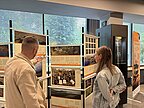
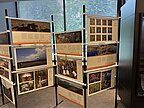
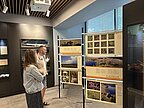
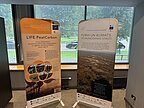
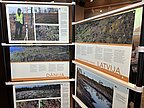
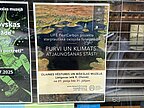

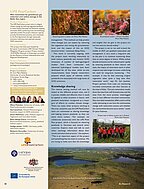
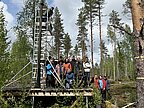
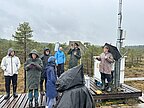
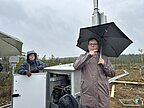
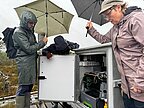
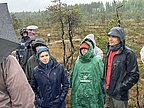
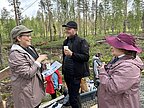
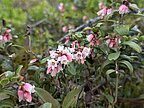
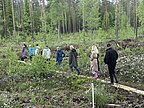
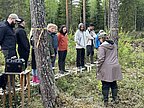
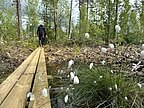
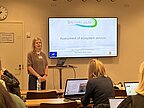
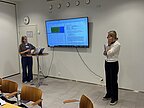
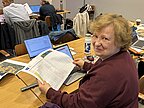
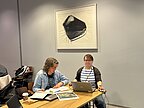
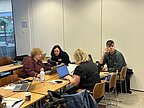
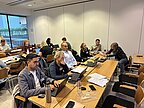
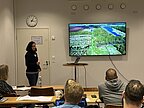
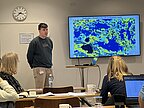

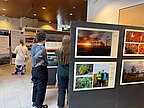
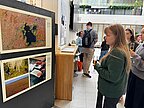
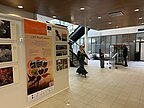
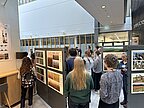
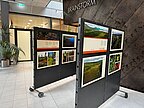
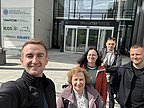
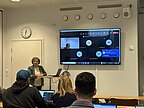
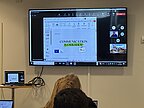
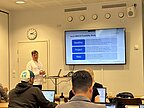
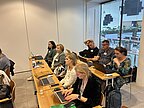
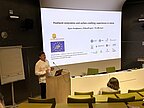
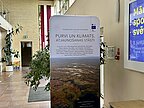
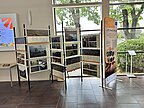
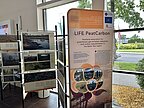












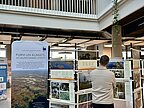
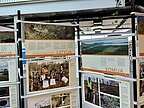
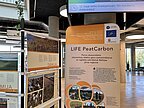
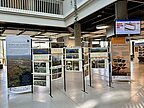
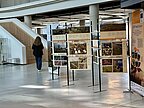
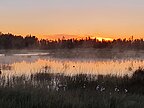
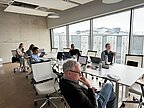
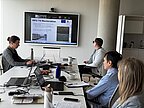
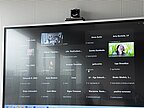
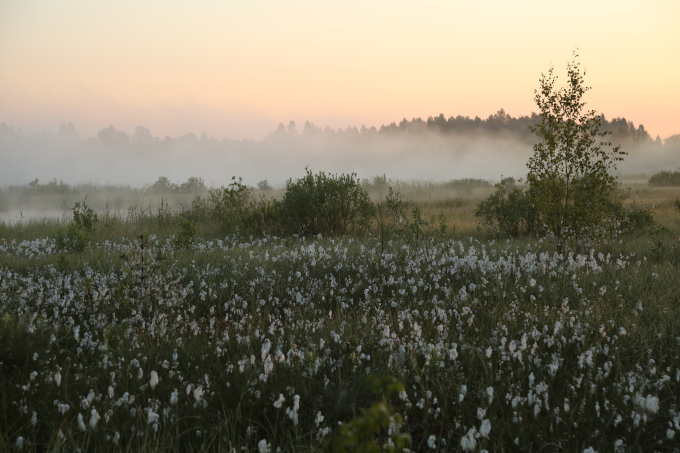
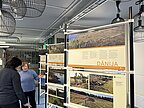
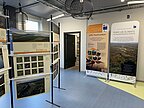
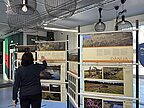
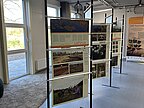
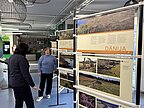
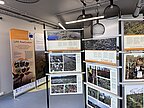
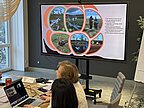
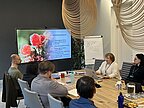
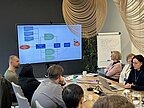
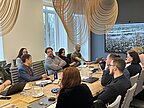
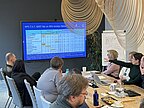
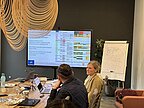
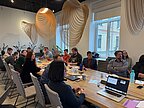



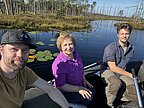
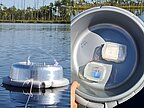
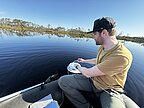
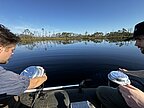
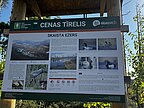
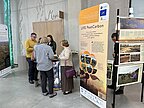
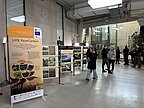
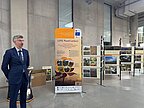








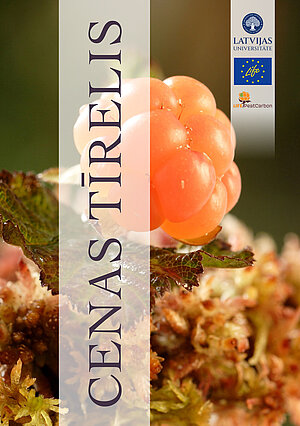
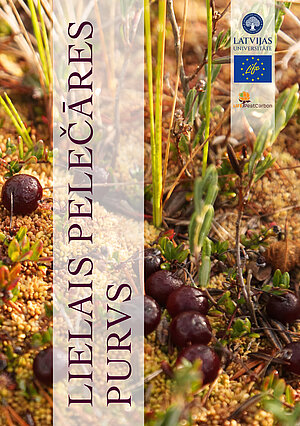
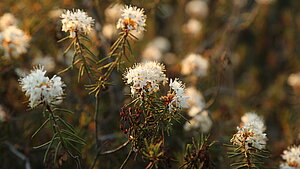
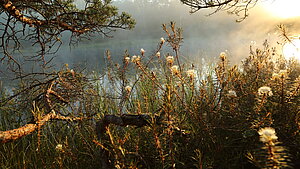
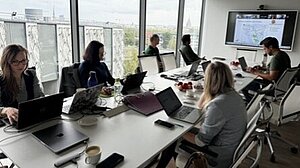
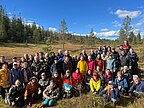
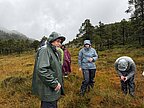
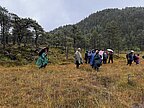
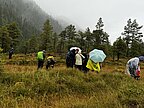
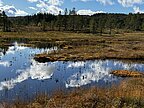
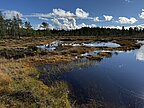
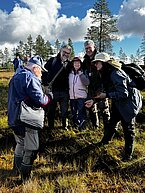
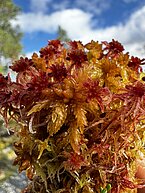
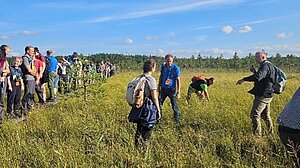
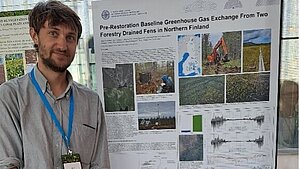
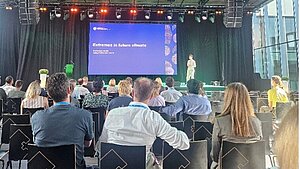
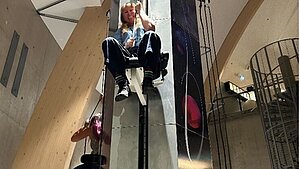
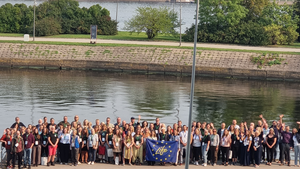
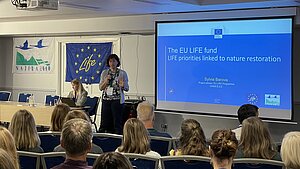
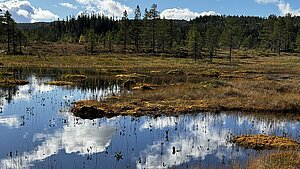
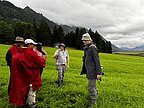
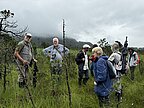
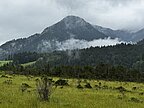
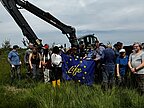
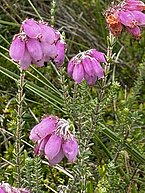
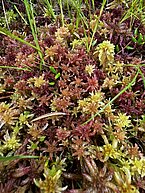
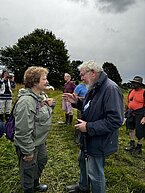
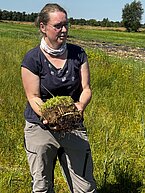
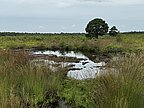

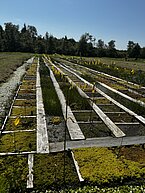













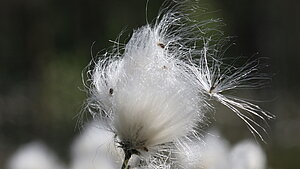
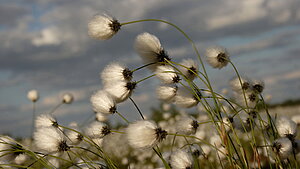


















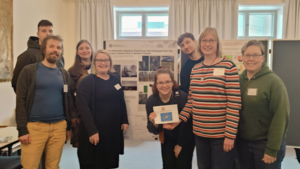
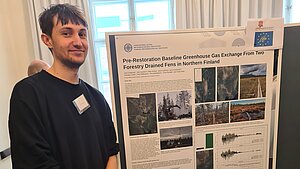
![[Translate to Angļu:] Figure 1](/fileadmin/_processed_/f/8/csm_Jenni_Figure1_82a53434ff.png)
![[Translate to Angļu:] Figure 2](/fileadmin/_processed_/8/3/csm_Jenni_Figure2_f227befacf.png)
![[Translate to Angļu:] Figure 3](/fileadmin/_processed_/7/4/csm_Jenni_Figure3_ce5de6dcc2.png)





![[Translate to Angļu:] Diskusijas pie Skaista ezera. Foto: Māra Pakalne](/fileadmin/_processed_/d/3/csm_Cena2_diskus_Mara_7M8A0075_deb52ad8f7.jpg)
![[Translate to Angļu:] Pārgājiena dalībnieku kopbilde. Foto: Declan O'Rourke](/fileadmin/_processed_/8/9/csm_Cena2_Foto_Declan_O_Rourkekopbilde_7M8A0101_7df133f8d7.jpg)
![[Translate to Angļu:] Pārgājiena dalībnieki Cenas tīrelī. Grupas sākumā Īrijas Zemkopības ministrijas zemes apsaimniekošanas un bioloģiskās daudzveidības ministre Pipa Haketa. Foto: Māra Pakalne](/fileadmin/_processed_/9/5/csm_Cena2_grupa_Mara_7M8A0060_1563854a9d.jpg)
![[Translate to Angļu:] Augstā purva veģetācija ar purva lāmām. Foto: Māra Pakalne](/fileadmin/_processed_/c/9/csm_Cena2_laama_Mara_7M8A0094_d198e221ec.jpg)
![[Translate to Angļu:] Skaista ezers Cenas tīrelī. Foto: Māra Pakalne](/fileadmin/_processed_/f/e/csm_Cena2_Mara_01bee104fc.jpg)
![[Translate to Angļu:] Augstajam purvam raksturīga ainava. Foto: Māra Pakalne](/fileadmin/_processed_/e/1/csm_Cena2_purvs_Mara_7M8A0081_ab0b229498.jpg)
![[Translate to Angļu:] Projekta vadītāja Māra Pakalne iepazīstina ar sfagnu sūnām. Foto: Pēteris Āboliņš](/fileadmin/_processed_/f/4/csm_Cena2_sfagni_Peteris_Abolins_13941b4ec5.jpg)
![[Translate to Angļu:] Māra Pakalne pasniedz ministrei LIFE projektos publicētās grāmatas. Foto: Pēteris Āboliņš](/fileadmin/_processed_/b/9/csm_Cena3_LIFEmat_Peteris_D7B50E4C-2439-472A-9495-4F606F1C69ED_c96002f88d.jpg)
![[Translate to Angļu:] Projekta PeatCarbon pārstāvji kopā ar Īrijas Zemkopības ministri](/fileadmin/_processed_/7/8/csm_CENA3_mala_5619BDCC-318A-45D7-92A8-A217ED102771_e6c5e30d78.jpg)
![[Translate to Angļu:] Informatīva pauze pie Skaista ezera. Foto: Māra Pakalne](/fileadmin/_processed_/5/2/csm_Cena_Andis_Mara_7M8A0074_2_0bbf481d24.jpg)
![[Translate to Angļu:] Māra Pakalne pastāsta par Cenas tīrelī sastopamajām dabas vērtībām. Foto: Pēteris Āboliņš](/fileadmin/_processed_/3/2/csm_Cena_info_Peteris_93564FE5-2BDD-417E-A585-D4D5D2504692_3c5d667c69.jpeg)
![[Translate to Angļu:] Īrijas vēstniecības pieņemšanā. No kreisās - Chris Boyle, Pēteris Āboliņš, ministre Pipa Haketa, Eimeara Frīla, Māra Pakalne. Foto: Deklans O'Rourke](/fileadmin/_processed_/b/9/csm_Foto_Declan_O_Rourke_IMG-20240319-WA0000_9832da8ddc.png)
